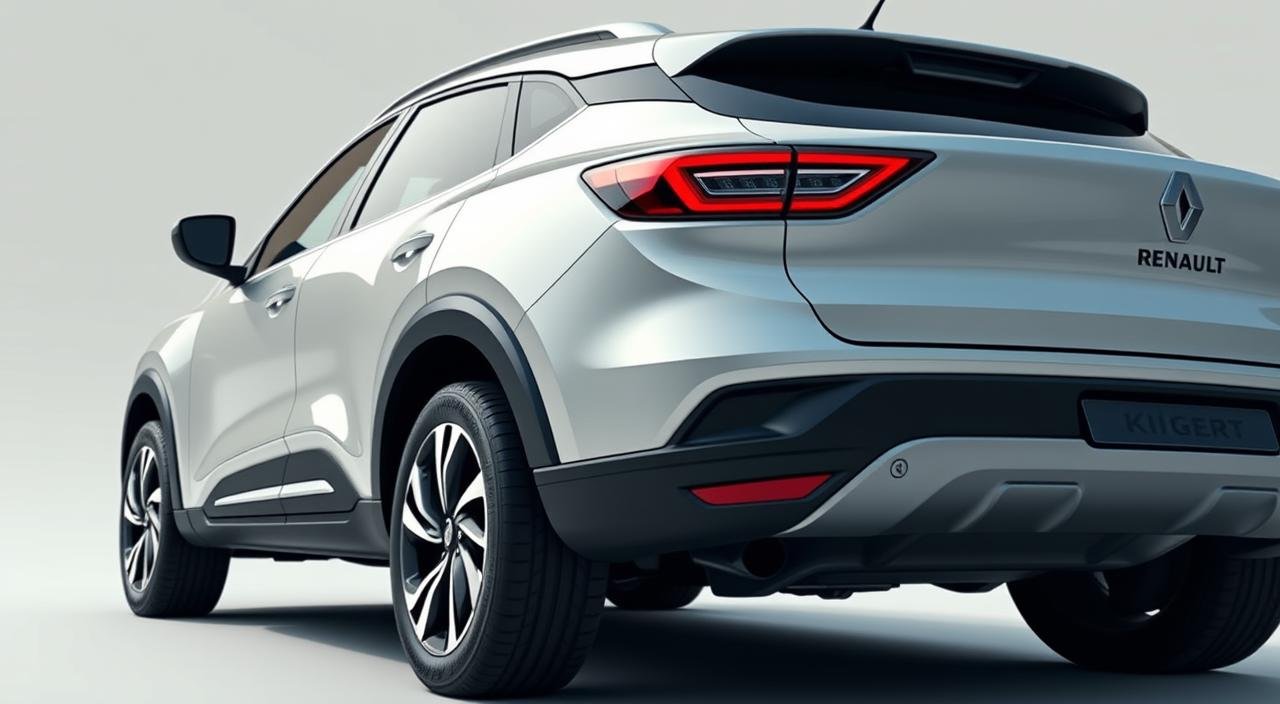
Oct
The 2025 Renault Kiger Facelift is here, bringing excitement to India’s compact SUV market. Renault India has launched its updated subcompact crossover. It comes with new design changes and more features.
The refreshed Kiger has new front and rear bumpers with silver accents. It also sports Renault’s latest logo. Prices start at Rs 6.29 lakh and go up to Rs 11.29 lakh ex-showroom. This puts it in a good spot against its rivals.
Bookings for the updated model are open online and at dealerships. Deliveries are starting across India. This is great news for those waiting for these Renault Kiger updates.
The facelift tackles previous issues with a better feature list and safety gear. You can choose from two petrol engines: a 72 PS naturally aspirated one and a 100 PS turbo-petrol.
Key Takeaways
- Updated styling with redesigned bumpers and silver accents
- Price range from Rs 6.29 lakh to Rs 11.29 lakh ex-showroom
- Two petrol engine options: 72 PS and 100 PS variants
- Enhanced safety features and equipment list
- Immediate availability with ongoing deliveries across India
- Direct competition with Nissan Magnite, Tata Punch, and Hyundai Exter
Introduction to the 2025 Renault Kiger Facelift
The car world is buzzing with the Renault Kiger Facelift’s upcoming release. This sub-4 meter SUV is set to make a big splash in India’s competitive market. It’s built on a proven platform, keeping its length and ground clearance just right for city driving and off-road fun.
A Quick Overview of the Kiger Model
The Kiger has quickly become a favorite for those looking for a budget-friendly car without sacrificing features. It earned a 4-star Global NCAP safety rating in 2022, giving buyers peace of mind. Renault Kiger design enhancements are available in four trims: Authentic, Evolution, Techno, and Emotion. Each trim meets different needs and budgets.
The prices are set to attract a wide range of buyers. The base model starts at Rs 6.29 lakh. The top model, the Emotion turbo-petrol manual, costs Rs 9.99 lakh. This makes the Kiger a great value.
Importance of Facelifts in the Automotive Industry
Facelifts are key updates for cars. They listen to customer feedback, add new tech, and keep cars fresh. The Kiger Facelift specifications show Renault’s dedication to making cars better without breaking the bank. These updates include new looks, tech, and quality boosts that keep a car relevant without the cost of a new model.
Exterior Enhancements
The 2025 Kiger Facelift brings a bold new look to Renault’s popular compact SUV. The updated design is more mature and sophisticated. It keeps the model’s adventurous spirit while following the latest trends and customer wishes in the Indian SUV market.
Redesigned Front Grille and Headlights
The front of the Kiger has been dramatically updated. It now has a new 10-slat grille with Renault’s modern 2D logo. Slim LED daytime running lights frame the grille, making it stand out.
The three-pod headlamp setup and sculpted bumper give the Kiger a strong, confident look. Glossy black accents add a premium feel. The LED fog lamps improve visibility and add to the SUV’s upscale look. The boomerang-shaped DRLs keep the Kiger’s unique identity while looking modern.
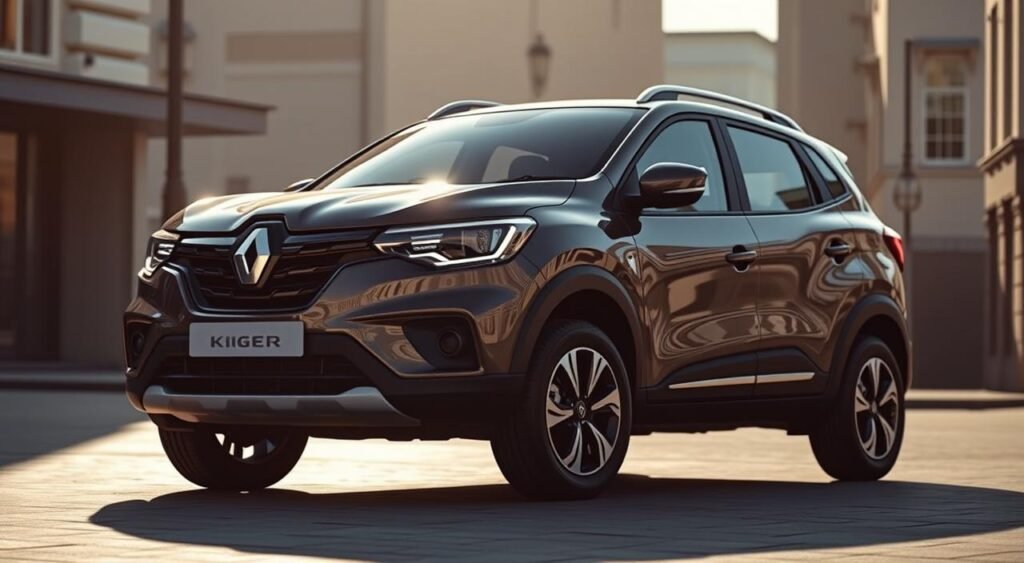
Sleek New Body Lines and Profile Changes
The side profile has been improved with bold wheel arch cladding and diamond-cut 16-inch alloy wheels. The floating roof design makes the Kiger look dynamic and appeals to young buyers. Roof rails support up to 50 kg of cargo, blending style with function.
At the back, clear-effect LED taillamps and a new bumper finish the makeover. These updates make the Kiger look good from every angle.
New Color Options Available
There are seven bright paint colors to choose from:
- Oasis Yellow
- Shadow Grey
- Caspian Blue
- Ice Cool White
- Moonlight Silver
- Stealth Black
- Radiant Red
Techno and Emotion trim buyers can pick dual-tone options with Mystery Black roof. This adds contrast and a premium look.
Interior Upgrades
The 2025 Kiger facelift brings big changes to the cabin. The new black and light grey dashboard looks sleek. The interior now has a dual-tone white-and-black theme, making it feel bigger and more welcoming.
Enhanced Dashboard Layout and Technology
The dashboard is both functional and premium. Controls are easy to reach, making daily use simple. Renault Kiger interior upgrades include 29 liters of storage space. This includes gloveboxes, deep door bins, and a large center console box.
Improved Material Quality and Comfort Features
Premium leatherette seats replace the old fabric ones, making the cabin more appealing. Hard plastics are used but feel durable. The rear seats offer plenty of knee room for tall passengers.
New Infotainment System
The 8.0-inch touchscreen infotainment system is the star. It supports wireless Apple CarPlay and Android Auto, keeping drivers connected without cables. The system is fast and shows clear graphics, improving the driving experience.
| Feature | Previous Model | 2025 Facelift |
|---|---|---|
| Dashboard Theme | Single tone | Black and light grey combination |
| Interior Color Scheme | Standard black | Dual-tone white and black |
| Seat Material | Fabric upholstery | Leatherette upholstery |
| Infotainment Screen | 7.0-inch display | 8.0-inch touchscreen |
| Smartphone Integration | Wired connection | Wireless Apple CarPlay/Android Auto |
| Storage Space | 25 liters | 29 liters |
| Glovebox Feature | Standard compartment | Cooled glovebox |
Performance Considerations
The 2025 Renault Kiger is made for Indian roads. It has two engine options and several transmission choices. This lets drivers pick the best setup for them. The car balances everyday use with good performance.
Engine Specifications and Variants
The Kiger Facelift has two engines. The base model has a 1.0-liter three-cylinder engine. It makes 72 horsepower and 96 Nm of torque. You can choose a five-speed manual or AMT transmission.
The turbocharged engine is more powerful. It’s also a 1.0-liter three-cylinder but turbocharged. It produces 100 horsepower and 160 Nm torque with manual. The CVT automatic gets 152 Nm torque.
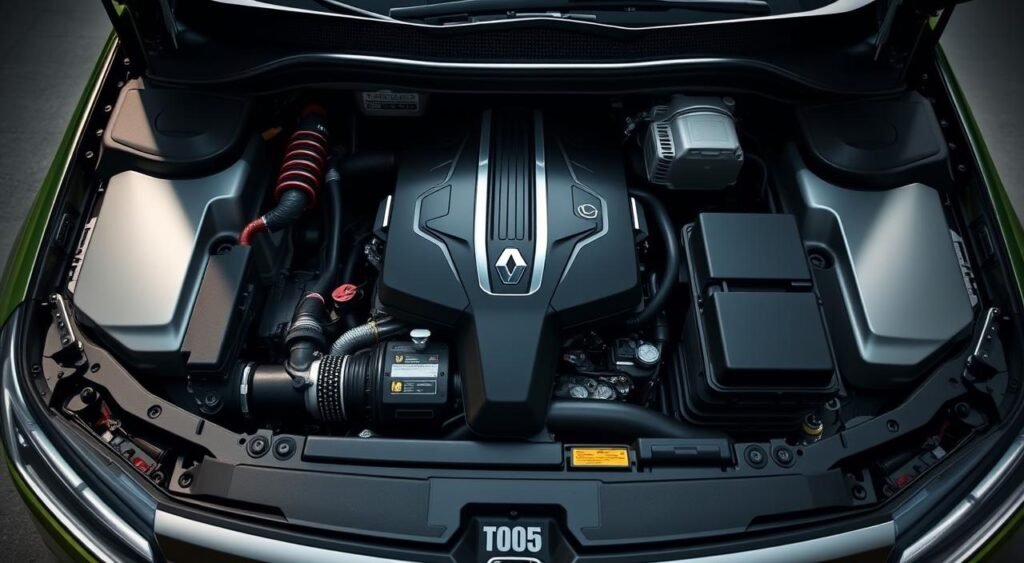
Suspension and Handling Improvements
The suspension is great for Indian roads, handling bumps well. The car is easy to drive in the city. On highways, it’s stable but rolls a bit in corners.
The CVT transmission makes driving smooth. It works well for city and highway driving.
Fuel Efficiency Overview
Fuel efficiency is a key feature of the Kiger. The naturally aspirated engine gets 19.71 kmpl with manual and 19.83 kmpl with AMT. The turbo-petrol engine does even better, at 20.38 kmpl with manual.
The CVT automatic gets 17.63 kmpl. This shows the Kiger is good on fuel.
Safety Features Introduced
The 2025 Renault Kiger boosts passenger safety with top-notch Renault Kiger safety features. It’s a great pick for Indian families. Renault has made the SUV safer with new tech and stronger structure for Indian roads.
Advanced Driver Assistance Systems
The new Kiger has the latest driver assistance tech to stop accidents. A 360-degree camera system makes parking easy. Hill start assist helps on steep hills.
Electronic Stability Program (ESP) keeps the vehicle steady in sudden moves or slippery roads. The Tyre Pressure Monitoring System (TPMS) warns when tire pressure is low. This helps avoid blowouts and saves fuel.
Improved Crash Test Ratings
The Kiger’s crash test ratings show Renault’s focus on safety. It got a 4-star rating from Global NCAP in 2022. It’s among the safest in its class.
It has six airbags for all passengers. All seats have 3-point seatbelts. ISOFIX mounts keep kids safe. The strong body absorbs crash impact, protecting everyone inside.
Visibility and Lighting Enhancements
Automatic LED headlamps adjust to light conditions, making night driving better. LED fog lamps and rain-sensing wipers help in fog and rain. These features keep the road clear, lowering accident chances.
Technology Additions
The 2025 Kiger brings modern tech to those on a budget. Renault has added smart features that match pricier cars. These updates make driving better without breaking the bank.
Infotainment System Updates
The tech upgrade includes an 8-inch touchscreen. It supports wireless Android Auto and Apple CarPlay, no cables needed. The system is fast and easy to use.
The audio system has improved, with 6-speaker Arkamys 3D surround sound. It makes music sound great during your drive.
Connectivity Options and Features
Renault knows drivers need many ways to stay connected. There’s a wireless phone charger and USB ports for charging. The multi-view camera system helps with parking.
There are three drive modes for different roads. Cruise control makes long drives easier. It helps reduce driver fatigue.
Driver Instrument Cluster Improvements
The 7-inch digital cluster shows important info clearly. You can see trip meters, fuel efficiency, and more easily. The push-button start and keyless entry add convenience.
The Techno variant comes with a smart access card. Automatic climate control and rear AC vents keep everyone comfy. Ventilated front seats cool you down quietly.
Comparative Analysis: 2025 Model vs. Previous Versions
The 2025 Renault Kiger is a big step up from its 2023 version. It has better safety, comfort, and tech. These changes fix old issues and keep prices low in India.
Key Differences from the 2023 Kiger
The 2025 Kiger has huge safety upgrades. Now, it comes with six airbags as standard. This is a big leap from the 2023 model’s limited safety features.
The inside of the car has changed a lot. It now has a brighter look with a dual-tone design. Ventilated seats are new, and the seats are made of leatherette. It also has cool tech like wireless phone connection and automatic lights.
How the Facelift Stands Against Competitors
The 2025 Kiger is a strong contender against cars like the Nissan Magnite and Hyundai Exter. It doesn’t have a sunroof, but it’s priced well and offers great value.
| Feature | 2025 Kiger | Key Rivals |
|---|---|---|
| Boot Space | 405 liters | 350-385 liters |
| Rear Legroom | Superior | Average |
| Standard Airbags | 6 | 2-4 |
Consumer Feedback on Changes
People love the new safety features and better interior. The ventilated seats are a big hit in India’s hot weather. The Kiger also beats the Kia Sonet and Hyundai Venue in space, making it great for families.
Pricing Models and Variants
The 2025 Renault Kiger comes in four trim levels, each for different needs and budgets. From the budget-friendly Authentic to the loaded Emotion, there’s something for everyone. Knowing the variant details helps buyers choose wisely based on their needs and budget.
Base Model vs. Top-End Variants
The Authentic starts at Rs 6.29 lakh. It has basic safety features like six airbags and LED lights. It also comes with power windows and 16-inch steel wheels.
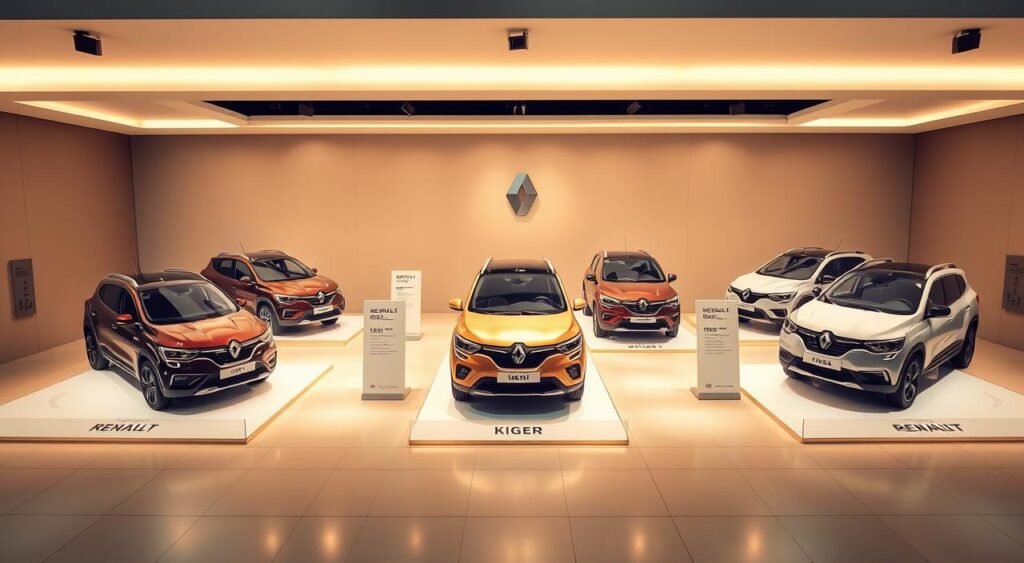
The Evolution adds useful features like an 8-inch touchscreen and rear AC vents. The Techno trim offers more, with triple LED headlamps and wireless phone connectivity.
The top Emotion variant costs Rs 11.29 lakh. It has luxury features like leather seats and a 360-degree camera. It also has automatic headlamps and 16-inch alloy wheels.
Estimated Pricing in the U.S. Market
The Renault Kiger pricing for the U.S. is not yet confirmed. But in India, the Techno variant is a great value. It has many features without a huge price jump. Note that engine options differ by trim.
| Variant | Price (Rs) | Key Features |
|---|---|---|
| Authentic | 6.29 lakh | 6 airbags, LED lights, power windows |
| Evolution | 7.85 lakh* | 8-inch touchscreen, rear camera, rear AC |
| Techno | 9.45 lakh* | Auto climate control, smart access, wireless connectivity |
| Emotion | 11.29 lakh | Ventilated seats, 360° camera, drive modes |
*Estimated pricing based on market positioning
Expected Release Date
The 2025 Renault Kiger debuted in India in August 2025. It officially launched and started deliveries on September 5, 2025. Now, the waiting time is up to three weeks due to high demand.
Timeline for U.S. Availability
Right now, U.S. availability for the 2025 Kiger is not confirmed. Renault has mainly focused on the Indian market. They engineered the Kiger for local roads and tastes.
There’s no word yet on when it might come to North America. The Kiger’s release date for other countries is also unclear.
Pre-order Options and Early Bird Specials
Indian buyers can find pre-order information online or at dealerships. The booking lets you choose from four accessory packages, introduced on August 27, 2025:
- Attractive Pack – exterior styling enhancements
- Essential Pack – practical daily-use accessories
- SUV Pack – off-road and adventure-focused additions
- Smart Pack – technology and connectivity upgrades
Renault has made the Kiger available across India. Americans interested in the Kiger should watch Renault’s official channels for updates on U.S. availability.
Target Audience for the 2025 Kiger
The 2025 Renault Kiger is perfect for many buyers. It offers practical and stylish mobility at a good price. It has lots of features, making it a great choice for those who want value without sacrificing safety or modern comforts.
Ideal Buyers and Demographics
The Kiger target audience includes various groups in India’s growing car market. First-time buyers like its easy-to-use features and automatic options. Young professionals, aged 25-35, enjoy its modern look and tech features that fit their digital lives.
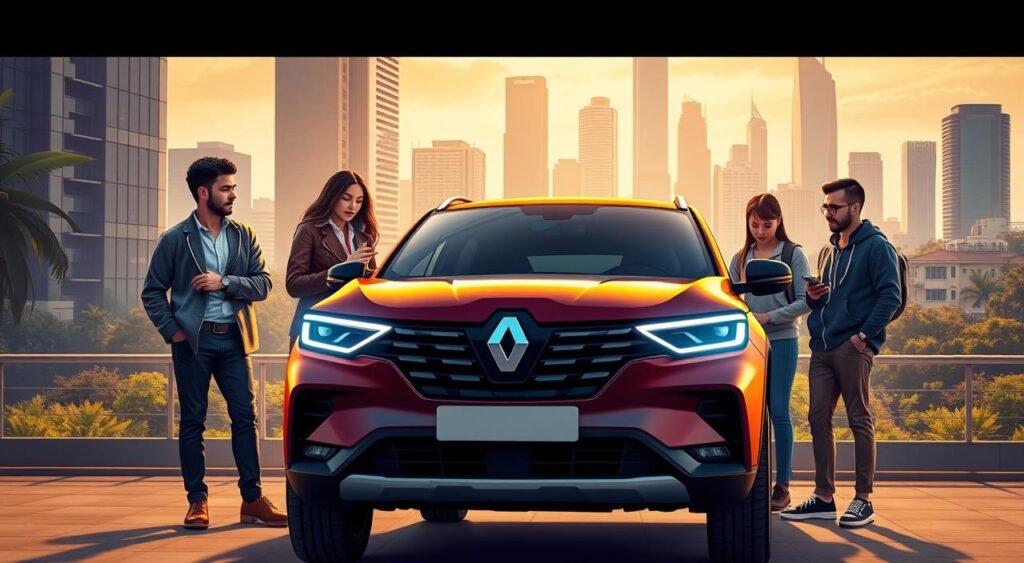
Small families love the Kiger’s roomy interior and 405-liter boot. It’s great for weekend trips and daily use. The 6 airbags and 4-star GNCAP safety rating make it a top choice for parents. City folks appreciate its small size and easy steering, making city driving a breeze.
Potential Market Reach
The buyer demographics go beyond big cities to smaller towns where affordable SUVs are scarce. Those looking for fuel-efficient cars will like the Kiger’s low running costs. The AMT and CVT automatic options make it a hit for those who prefer ease in city traffic.
| Buyer Segment | Key Priorities | Kiger Appeal |
|---|---|---|
| Young Professionals | Style, Technology | Modern design, Connected features |
| Small Families | Space, Safety | 405L boot, 6 airbags |
| First-time Buyers | Value, Simplicity | Competitive pricing, Easy handling |
| City Commuters | Efficiency, Convenience | Fuel economy, Automatic options |
Environmental Impact Considerations
The 2025 Renault Kiger shows Renault’s dedication to lowering its Kiger environmental impact. It does this through smart engineering and design. With worries about climate change and air quality in Indian cities, Renault added eco-friendly features to this compact SUV. These features help the environment and save money for the owner.
Eco-Friendly Innovations
The Kiger’s fuel-efficient engines are a big plus for the environment. It can go up to 20.38 kilometers per liter, saving fuel. The naturally aspirated version works with government-approved CNG kits, making it a clean and affordable choice.
The new front design cuts down on drag, making it more fuel-efficient. Renault chose to use only cleaner petrol engines, skipping diesel. Key sustainability features include:
- Lightweight materials that save fuel
- Recyclable parts inside
- Engines that meet emission standards
- Space-saving design
Manufacturing Sustainability Efforts
Renault’s Chennai plant uses green manufacturing methods. The CMF-A+ platform, shared with Nissan, cuts down on waste. This shared platform helps both brands save on development costs and improve component efficiency.
The Kiger is built to last, reducing the need for frequent replacements. This shows Renault knows today’s buyers want cars that are good for the planet and perform well.
Conclusion: Is the 2025 Renault Kiger Worth It?
The 2025 Renault Kiger facelift makes smart changes without a big overhaul. This keeps the price down while fixing past issues. It adds features that Indian families love.
Final Thoughts on the Facelift Updates
The Kiger facelift review shows great updates where they’re needed. It comes with six airbags as standard, showing a big step in safety. It also has ventilated seats and automatic headlamps, adding luxury touches.

- Enhanced safety features across all variants
- Better comfort amenities for daily use
- Maintained fuel efficiency for budget-conscious buyers
- Improved cabin materials in critical touchpoints
Anticipated Customer Reactions
Customers seem to be happy with these updates. Families will love the extra safety. The verdict is that people will like the mix of value and practicality.
| Aspect | Previous Model | 2025 Facelift |
|---|---|---|
| Standard Airbags | 4 | 6 |
| Ventilated Seats | Not Available | Available |
| Boot Space | 405 liters | 405 liters |
| Automatic Headlamps | Top Variant Only | Mid Variant Onwards |
This update makes the Kiger better without raising the price. Budget-conscious buyers seeking reliable family transport will find the 2025 model meets their needs.
Call to Action: Explore the New Kiger
The 2025 Renault Kiger facelift is packed with exciting updates. It’s a big deal for the popular compact SUV. You can check out its new features through various channels.
The Kiger now looks better and works better, thanks to its style upgrades and practical improvements. Taking it for a spin helps you see its value. It’s a great way to understand what makes it special.
Where to Find More Information
The Renault India website has all the details on the Kiger. You can use online tools to compare different trims and customize your model. The website also has virtual showrooms to show off the SUV’s features.
Customer reviews and expert comparisons give you real insights into the Kiger’s performance. The website also has tools to help with financing and exchange bonuses for current owners.
Schedule a Test Drive or Visit a Dealership
Renault dealerships across India are ready to let you test drive the Kiger. The staff will explain the trim options and help you pick the right one. They’ll also talk about service networks and warranties.
When you visit, you can discuss insurance and extended warranties. Booking a test drive online is easy. Showrooms also have accessory packs and customization options to explore.
FAQ
What are the key updates in the 2025 Renault Kiger Facelift?
The 2025 Kiger Facelift has new front and rear bumpers with silver accents. It also has Renault’s latest 2D logo and a new 10-slat grille. LED fog lamps and clear effect LED taillamps are added.
FAQ
What are the key updates in the 2025 Renault Kiger Facelift?
The 2025 Kiger Facelift has new front and rear bumpers with silver accents. It also has Renault’s latest 2D logo and a new 10-slat grille. LED fog lamps and clear effect LED taillamps are added.
What are the Renault Kiger new features in terms of safety?
FAQ
What are the key updates in the 2025 Renault Kiger Facelift?
The 2025 Kiger Facelift has new front and rear bumpers with silver accents. It also has Renault’s latest 2D logo and a new 10-slat grille. LED fog lamps and clear effect LED taillamps are added.
FAQ
What are the key updates in the 2025 Renault Kiger Facelift?
The 2025 Kiger Facelift has new front and rear bumpers with silver accents. It also has Renault’s latest 2D logo and a new 10-slat grille. LED fog lamps and clear effect LED taillamps are added.
What engine options are available in the 2025 Kiger?
FAQ
What are the key updates in the 2025 Renault Kiger Facelift?
The 2025 Kiger Facelift has new front and rear bumpers with silver accents. It also has Renault’s latest 2D logo and a new 10-slat grille. LED fog lamps and clear effect LED taillamps are added.
FAQ
What are the key updates in the 2025 Renault Kiger Facelift?
The 2025 Kiger Facelift has new front and rear bumpers with silver accents. It also has Renault’s latest 2D logo and a new 10-slat grille. LED fog lamps and clear effect LED taillamps are added.
How much does the 2025 Renault Kiger cost?
FAQ
What are the key updates in the 2025 Renault Kiger Facelift?
The 2025 Kiger Facelift has new front and rear bumpers with silver accents. It also has Renault’s latest 2D logo and a new 10-slat grille. LED fog lamps and clear effect LED taillamps are added.
What are the Renault Kiger design enhancements?
FAQ
What are the key updates in the 2025 Renault Kiger Facelift?
The 2025 Kiger Facelift has new front and rear bumpers with silver accents. It also has Renault’s latest 2D logo and a new 10-slat grille. LED fog lamps and clear effect LED taillamps are added.
FAQ
What are the key updates in the 2025 Renault Kiger Facelift?
The 2025 Kiger Facelift has new front and rear bumpers with silver accents. It also has Renault’s latest 2D logo and a new 10-slat grille. LED fog lamps and clear effect LED taillamps are added.
What technology features does the 2025 Kiger offer?
FAQ
What are the key updates in the 2025 Renault Kiger Facelift?
The 2025 Kiger Facelift has new front and rear bumpers with silver accents. It also has Renault’s latest 2D logo and a new 10-slat grille. LED fog lamps and clear effect LED taillamps are added.
When will the 2025 Renault Kiger be available?
FAQ
What are the key updates in the 2025 Renault Kiger Facelift?
The 2025 Kiger Facelift has new front and rear bumpers with silver accents. It also has Renault’s latest 2D logo and a new 10-slat grille. LED fog lamps and clear effect LED taillamps are added.
How does the 2025 Kiger compare to its competitors?
FAQ
What are the key updates in the 2025 Renault Kiger Facelift?
The 2025 Kiger Facelift has new front and rear bumpers with silver accents. It also has Renault’s latest 2D logo and a new 10-slat grille. LED fog lamps and clear effect LED taillamps are added.
What are the different trim levels available?
FAQ
What are the key updates in the 2025 Renault Kiger Facelift?
The 2025 Kiger Facelift has new front and rear bumpers with silver accents. It also has Renault’s latest 2D logo and a new 10-slat grille. LED fog lamps and clear effect LED taillamps are added.
Is the 2025 Renault Kiger fuel-efficient?
FAQ
What are the key updates in the 2025 Renault Kiger Facelift?
The 2025 Kiger Facelift has new front and rear bumpers with silver accents. It also has Renault’s latest 2D logo and a new 10-slat grille. LED fog lamps and clear effect LED taillamps are added.
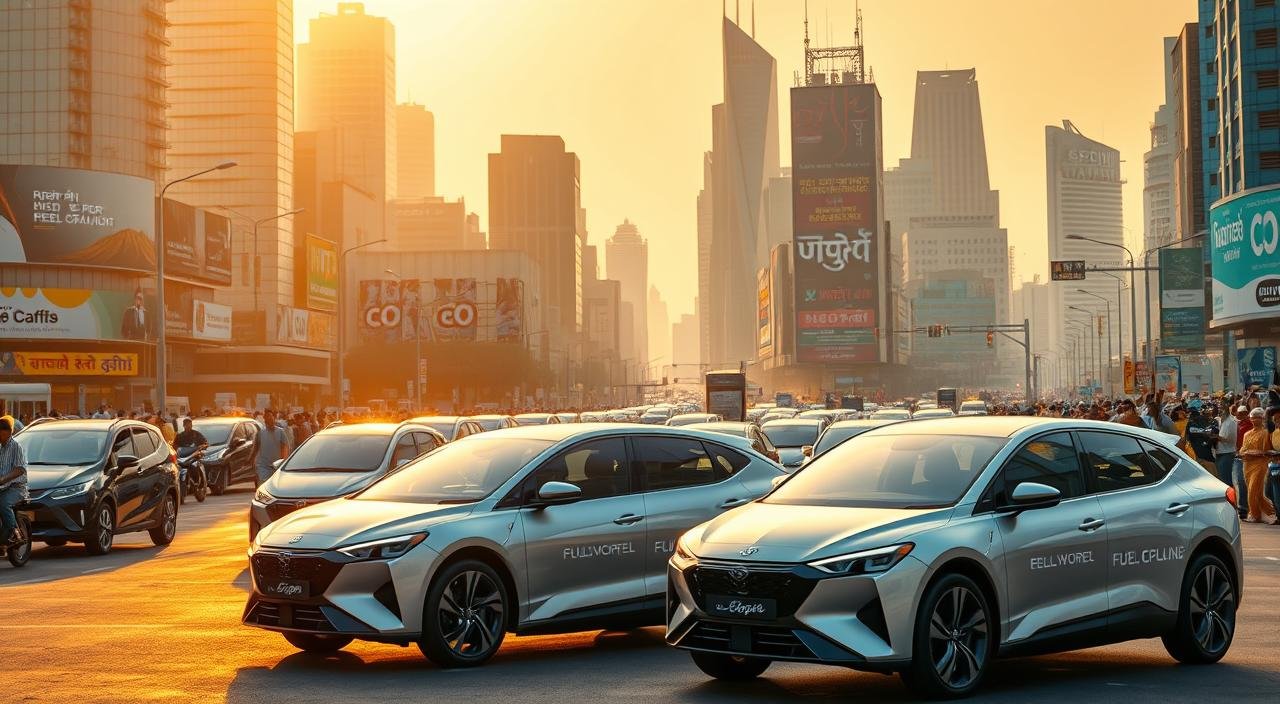
Oct
The Indian car market is on the verge of a big change. The government has announced a 5% GST rate for fuel-cell cars, starting September 22, 2025. This move puts hydrogen vehicles on the same level as petrol and diesel cars, changing the game.
Five key fuel-cell vehicles are set to hit the Indian market. Thanks to the lower GST rate, these cars will be more affordable for people looking for green options. This is a big win for those wanting to switch from traditional engines.
Now is the perfect time for this change. Global car makers are adding more fuel-cell models to their lines. With the 5% GST, fuel-cell cars in India can compete with traditional cars on price. This move shows India’s dedication to hydrogen technology in the car industry.
Key Takeaways
- India reduces GST on fuel-cell vehicles to 5%, matching rates for petrol and diesel cars
- Five hydrogen vehicles are prime candidates to launch in India following the tax benefit
- The policy takes effect September 22, 2025, making FCVs more affordable for buyers
- Fuel-cell cars now enjoy equal tax treatment with conventional vehicles for the first time
- Major automakers are preparing to introduce hydrogen models to capitalize on the incentive
- The GST reduction could accelerate India’s shift toward zero-emission transportation
Understanding Fuel-Cell Technology
Fuel-cell technology is a big step forward in cars, making them cleaner and more efficient. In India, people are looking for better ways to travel than old gas engines. FCVs are a top choice because they use hydrogen to make electricity, leading the way in green cars.
What Are Fuel-Cell Vehicles (FCVs)?
FCVs run on hydrogen fuel cells, making electricity from hydrogen and oxygen. They don’t burn gas like regular cars, so they only make water vapor and heat. This means no big batteries are needed, unlike electric cars.
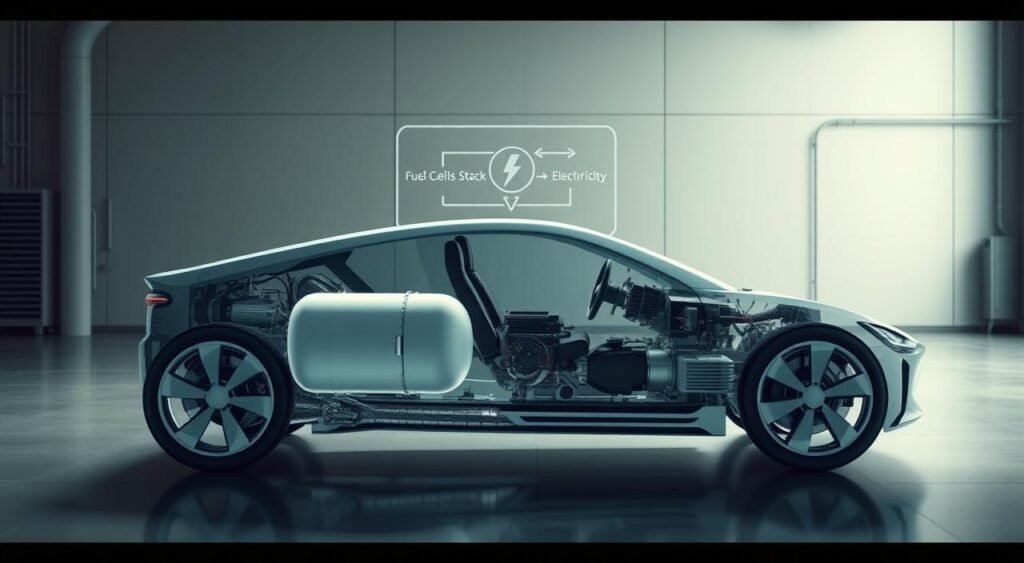
How Do Fuel Cells Work?
Fuel cells work by breaking down hydrogen into protons and electrons. The electrons make electricity for the car’s motor. Oxygen and the protons make water vapor, the only thing these cars emit.
Key Benefits of Fuel-Cell Technology
Hydrogen cars have many good points:
- Rapid refueling: Fill up in just 3-5 minutes, like gas cars
- Extended range: Go 400-600 kilometers on one tank
- Zero emissions: Only make water vapor
- Energy efficiency: Use 60% of fuel energy for power
- Quiet operation: Make very little noise
| Feature | FCVs | Traditional Vehicles |
|---|---|---|
| Refueling Time | 3-5 minutes | 5-7 minutes |
| Emissions | Water vapor only | CO2, NOx, particulates |
| Energy Efficiency | 60% | 20-35% |
| Range per Tank | 400-600 km | 500-800 km |
The Current State of Fuel-Cell Cars in India
The Indian car market is changing, moving from old engines to new, cleaner ones. Electric cars are getting popular, but fuel-cell cars are also gaining attention. The car industry in India, worth over $100 billion, is looking into hydrogen cars as a green option.
Overview of the Indian Automobile Market
India has a huge car market, with over 3.8 million cars sold every year. Big names like Toyota, Hyundai, and Tata Motors lead the market. Toyota, for example, has 12 models, but no fuel-cell cars yet.
People are starting to want cleaner cars because of pollution and bad air in cities. This interest could help fuel-cell cars become more common in India.

Government Policies Supporting FCVs
The government is backing hydrogen cars with new rules. They want to make fuel-cell cars cheaper to buy. In 2022, the government started a program with Toyota to test hydrogen cars.
Some key policies include:
- A new plan to make more green hydrogen
- Help for companies making fuel-cell cars
- Money for building hydrogen stations
- Tests in some cities to see how well they work
Challenges Facing FCV Adoption in India
Fuel-cell cars in India face big challenges. The biggest one is the lack of places to fill up with hydrogen. Hydrogen stations need special equipment and safety measures.
Other problems are the high cost of these cars, not many people know about them, and electric cars are also popular. The car industry, government, and others need to work together to make hydrogen cars a reality in India.
Financial Implications of GST on Fuel-Cell Vehicles
The introduction of a 5% GST rate for fuel-cell vehicles is a big deal for India’s car market. This lower tax makes these eco-friendly cars more affordable than regular cars. It means buyers can get advanced hydrogen technology at a better price.
What is GST and How Does It Work?
Goods and Services Tax (GST) is India’s single tax system that replaced old taxes. For cars, GST rates change based on the car’s type and features. Most cars face a GST rate between 18% and 28%, with extra taxes making it even higher.
The 5% GST for fuel-cell vehicles is the lowest tax for cars in India. This lower tax is a big help for these cars, which are good for the environment. It encourages more people to buy them.
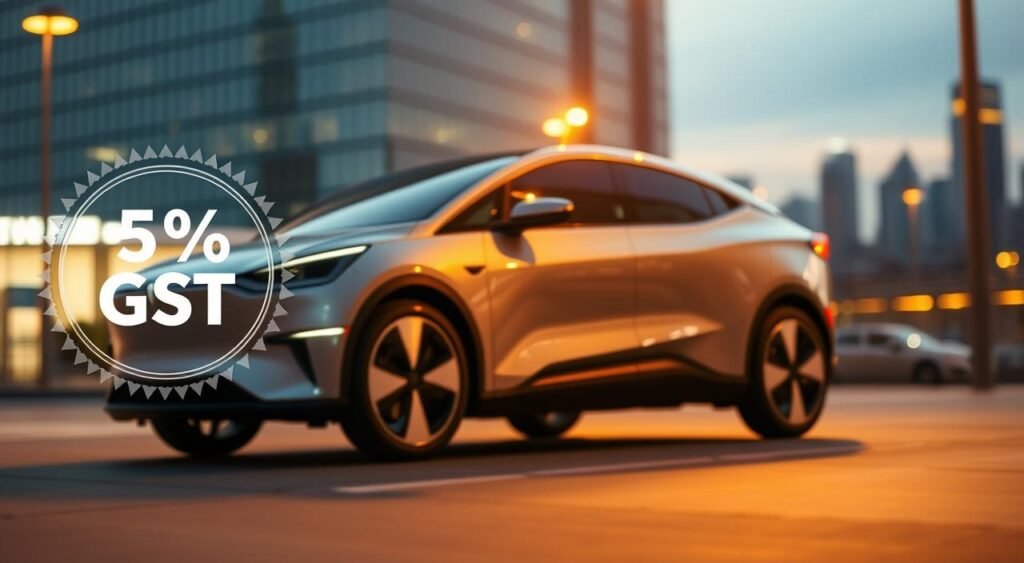
Impact of 5% GST on FCV Pricing
The lower GST rate saves a lot of money for buyers. For example, a fuel-cell car priced at Rs. 60 lakh gets a GST of just Rs. 3 lakh. This is much less than the taxes on regular luxury cars.
Comparisons with Other Vehicle Categories
| Vehicle Category | GST Rate | Additional Cess | Total Tax Impact |
|---|---|---|---|
| Fuel-Cell Vehicles | 5% | 0% | 5% |
| Electric Vehicles | 5% | 0% | 5% |
| Petrol/Diesel Cars | 28% | 1-20% | 29-48% |
| Hybrid Vehicles | 28% | 15% | 43% |
Fuel-cell vehicles now have the same tax benefits as electric vehicles. This makes them the most affordable eco-friendly cars to buy. They also get extra state incentives and lower fees in many places.
Five Fuel-Cell Vehicles Emerging in India
India’s car market is changing fast. Big names are getting ready to bring hydrogen cars to the roads. These cars use new tech that could change how we travel. Let’s look at the top FCVs that might get cheaper soon.
Toyota Mirai: A Trailblazer in FCVs
The Toyota Mirai is a leader in hydrogen cars worldwide. It’s a sleek sedan with over 180 PS power. It can go 600-650 kilometers on one tank, making long trips easy.
What’s cool about the Mirai is how fast it refuels. Just five minutes to fill up. It’s been improved over the years, making it even better.
Hyundai Nexo: An Innovative Approach
Hyundai’s Nexo is a mid-size SUV, like the Tucson. It goes over 700 kilometers on a single tank. It also refuels quickly, in just five minutes.
This SUV is great for families. It’s big and has the latest fuel-cell tech. It’s a top choice for those wanting a big, green car.
Honda Clarity: Features and Benefits
Honda’s CR-V FCEV is different. It has a hydrogen fuel cell and a 17.7 kWh battery. This combo gives it a 450-kilometer range.
It’s special because you can use electric power too. This makes it very versatile, unlike most FCVs.
Tata Motors’ Future Projections
While big brands lead, Tata Motors is also working on hydrogen cars. They see the value of fuel cells for India. They’re making cars that fit India’s needs and infrastructure.
How 5% GST Could Boost FCV Sales
The introduction of a 5% GST rate for fuel-cell cars in India is a big deal. It makes fuel-cell cars more affordable for both makers and buyers. This could change the game for clean energy vehicles in the market.
Potential for Increased Adoption Rates
The 5% GST rate lowers the cost of fuel-cell cars in India. This makes them more appealing to a wider range of people. Electric vehicles, on the other hand, face GST rates between 12% to 28%.
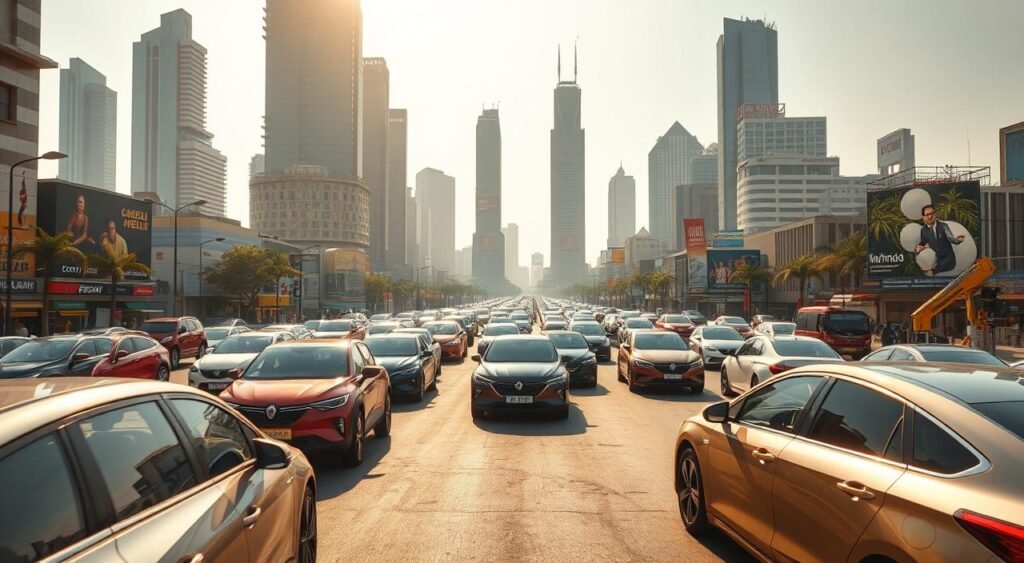
Lower taxes could lead to a 30-40% increase in FCV adoption in the first two years. Fleet operators and corporate buyers are interested in FCVs. They like the quick refueling and longer driving ranges compared to electric cars.
Encouragement for Manufacturers and Investors
The reduced GST rate shows India’s commitment to hydrogen technology. Big names like Toyota and Hyundai are thinking about bringing their hydrogen models to India. The tax benefits make it easier to produce and sell these cars locally, attracting more investment.
Consumer Awareness and Education
For FCVs to succeed, people need to understand their benefits. Zero tailpipe emissions, fast refueling, and long driving ranges are key. Industry groups and the government are working on campaigns to spread the word about these advantages and the 5% GST rate.
Environmental Impact of Fuel-Cell Vehicles
Fuel-cell vehicles are a big step forward in clean energy cars. They help India move towards a greener future. Unlike gas cars, FCVs only release water vapor, not harmful pollutants.
This is great news for India’s air quality and its environmental goals.
Reducing Carbon Emissions
Fuel-cell vehicles don’t have tailpipe emissions, making them eco-friendly cars. Each FCV can cut down about 4.6 metric tons of CO2 a year. This is a big deal for cities like Delhi and Mumbai, which are really struggling with air pollution.
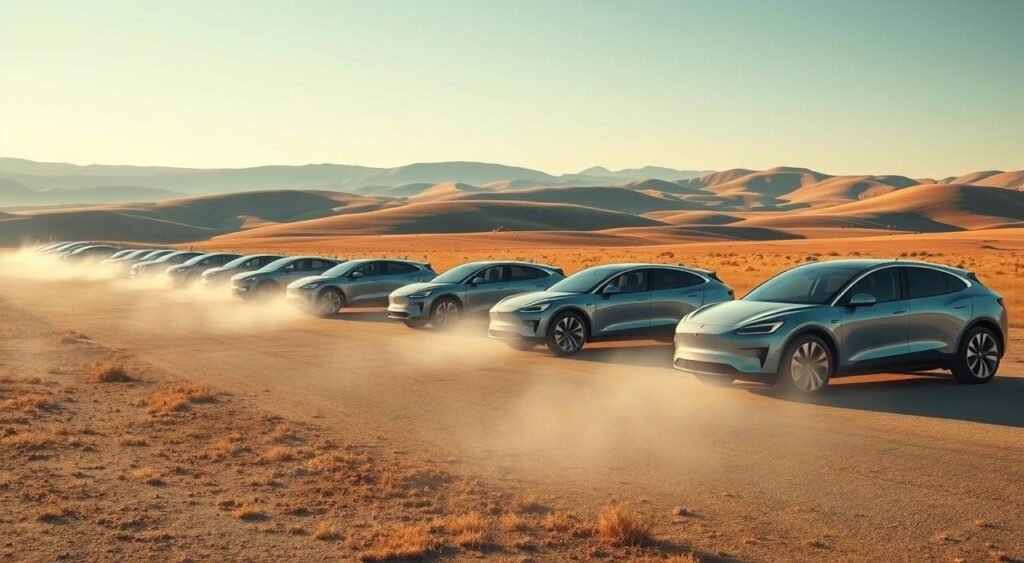
The Role of Renewable Energy in FCVs
The good news about green vehicles goes beyond zero emissions. If hydrogen is made from solar or wind power, FCVs are totally carbon-neutral. India’s growing solar farms in places like Rajasthan and Gujarat are perfect for making clean hydrogen.
Long-term Sustainability Benefits
FCVs have big advantages over electric cars in how they affect the environment. They don’t have the lithium mining and battery disposal issues. They also need fewer rare earth materials and last longer.
As India builds its hydrogen network, these clean energy cars will be key to reaching its 2070 net-zero emissions goal.
FCVs vs. Battery Electric Vehicles (BEVs)
The Indian car market is at a turning point. It’s between fuel-cell vehicles and battery electric vehicles. Each has its own benefits for those who care about the environment. Knowing the differences helps people choose the right car for them.
Comparing Performance and Efficiency
Fuel-cell vehicles are quick to refuel, taking only 3-5 minutes. This is much faster than charging electric cars, which can take hours. They also have a long range, up to 820 kilometers per tank, beating many electric cars.
Battery electric vehicles are better at using energy, turning 77% of it into power. Fuel-cell cars are about 60% efficient. Both types don’t emit any pollution, making them good choices for clean energy.
Cost Considerations and Long-term Value
There’s a big price difference at the start:
| Vehicle Type | Average Price Range (INR) | Fuel Cost per 100km | Maintenance Frequency |
|---|---|---|---|
| Fuel-Cell Vehicles | 50-65 lakhs | ₹400-500 | Every 10,000 km |
| Battery Electric Vehicles | 15-35 lakhs | ₹80-150 | Every 15,000 km |
BEVs are cheaper to run, which appeals to those watching their budget. Fuel-cell cars need less battery replacement, which could save money in the long run, even if they cost more upfront.
Infrastructure Needs for Both Technologies
Building more charging stations is key for both types. India had over 1 million EV charging points by 2019. But, hydrogen cars have fewer places to refuel.
Setting up hydrogen stations is expensive, costing ₹15-20 crores each. EV charging is easier to expand, with many people able to charge at home. Both need more stations to become more popular in India.
The Role of Government in Promoting FCVs
The government is key in shaping the future of fuel-cell cars in India. They are making policies and partnerships to help hydrogen cars grow. The 5% GST rate is a big step towards making cars more affordable and sustainable.
Incentives for Consumers and Businesses
The Indian car industry is getting a lot of support from the government. The 5% GST rate makes fuel-cell cars cheaper than regular cars. This can save people around ₹5-10 lakhs on high-end FCVs.
- Direct purchase subsidies under the FAME scheme
- Tax deductions for businesses adopting hydrogen fleets
- Reduced road tax and registration fees in select states
- Priority parking and toll exemptions for FCV owners
Collaborations with Automotive Manufacturers
Partnerships between the government and car makers are speeding up FCV development. The 2022 pilot program with Union Minister Nitin Gadkari testing the Toyota Mirai was a big moment. These partnerships include research and technology sharing with Toyota and Hyundai.
Future Policy Directions
The future plans include building more hydrogen stations and growing the market. They aim to have 100 stations by 2030 in big cities. The goal is to use green hydrogen made from renewable energy, making cars run on clean energy.
Policy frameworks are being drafted to standardize hydrogen fuel quality and safety protocols, creating a strong ecosystem for the industry’s future.
Public Perception and Acceptance of FCVs
In India, understanding hydrogen vehicles is a big challenge. Many people don’t know how FCVs work or their benefits. We need to clearly explain how they work and address concerns to gain trust.
Common Misconceptions About Fuel-Cell Technology
Many myths about FCVs slow their adoption. Some think they’re dangerous because of fuel storage. But, modern hydrogen tanks are tested and safe.
Another myth is that they can’t go far. The Toyota Mirai can go over 400 miles on one tank, just like gas cars. High costs are also a worry. But, running them is cheaper, and refueling is quick.
Japan and South Korea have shown FCVs are reliable. But, many in India don’t know this.
Educational Initiatives for Consumers
Car makers and governments are working to teach people about FCVs. They offer test drives and share info online. They also train dealers and service centers.
Success Stories from Early Adopters
The 2022 Toyota Mirai pilot in New Delhi was a success. Fleet operators were happy with the cars’ performance. Programs in California and Germany offer lessons for India.
Companies using hydrogen vehicles save money and help the environment. This encourages more people to accept them.
The Future of Fuel-Cell Cars in India
India is at a turning point with fuel-cell cars set to change its car scene. A 5% GST cut opens doors for eco-friendly cars to enter the market. Big names like Toyota and Hyundai are getting ready to launch their fuel-cell models. Tata Motors, a local company, is also diving into this exciting tech.
But, there’s a lot of work ahead. We need to plan well and invest in hydrogen infrastructure.
Predictions for Market Growth
Experts think fuel-cell cars in India will grow slowly but surely over the next ten years. The Toyota Mirai and Hyundai Nexo are set to be the first ones on the market. BMW’s iX5 Hydrogen and Honda’s CR-V FCEV are also waiting for the right time to come out.
They predict that by 2030, hydrogen cars could grab 2-3% of the premium car market. This will happen if we have more hydrogen stations and teach people about fuel-cell tech.
Technological Advances on the Horizon
New tech in fuel cells promises better efficiency and lower costs. Engineers are working on better hydrogen storage and using less platinum in fuel cells. The Toyota Crown shows off advanced fuel-cell tech that might come to India.
Improvements in battery tech are also helping fuel cells. They’re making hybrid systems that use both power sources. These changes make eco-friendly cars more suitable for Indian roads and driving habits.
Closing Thoughts on the Importance of FCVs in India
Fuel-cell vehicles are key for India’s clean transport future. The GST cut shows the government’s support for green vehicles, not just battery electric ones. Success needs teamwork between car makers, energy firms, and government to build hydrogen stations.
The path to making fuel-cell cars common in India is long. But, the steps we take today will shape tomorrow’s transport. As India seeks energy freedom and cleaner air, fuel-cell cars are a vital option that deserves our support.
FAQ
What is the new GST rate for fuel-cell vehicles in India?
The GST rate for fuel-cell vehicles in India has been cut to 5%. This change took effect on September 22, 2025. It makes FCVs more affordable, putting them in a better tax position than traditional vehicles.
How do hydrogen vehicles differ from battery electric vehicles?
Hydrogen vehicles use hydrogen as fuel and can refuel quickly, like regular cars. Battery electric vehicles take longer to charge. FCVs have long driving ranges and zero tailpipe emissions, making them eco-friendly and convenient.
Which fuel-cell cars could launch in the Indian automotive industry?
Five FCVs might soon hit the Indian market. These include the Toyota Mirai, Hyundai Nexo, Honda CR-V FCEV, BMW iX5 Hydrogen, and Toyota Crown. They offer various styles and power, from 180 PS to over 400 PS.
What are the main challenges facing clean energy cars adoption in India?
The biggest hurdle is the lack of hydrogen refueling stations. India has many EV charging points but few for hydrogen. Despite government support, building more stations is key for wider adoption.
What are the environmental benefits of green vehicles like FCVs?
FCVs emit no tailpipe emissions, making them better for the environment than traditional cars. They use hydrogen instead of lithium-ion batteries, reducing environmental impact. This supports India’s goal for cleaner energy and lower carbon emissions.
How does the 5% GST benefit compare to other eco-friendly cars?
The 5% GST rate makes FCVs cheaper for buyers. This tax advantage makes premium FCVs like the Toyota Mirai more competitive in India. It’s a big plus compared to cars with higher GST rates.
What role has the government played in promoting fuel-cell cars in India?
The government has backed FCVs with a 5% GST rate and pilot programs. The 2022 Toyota Mirai study shows their commitment. But, more work is needed to improve infrastructure.
How long does it take to refuel a hydrogen vehicle?
Refueling hydrogen vehicles takes just 3-5 minutes, similar to traditional cars. This is a big plus over battery electric vehicles, which take hours to charge. It makes FCVs great for long trips and quick stops.
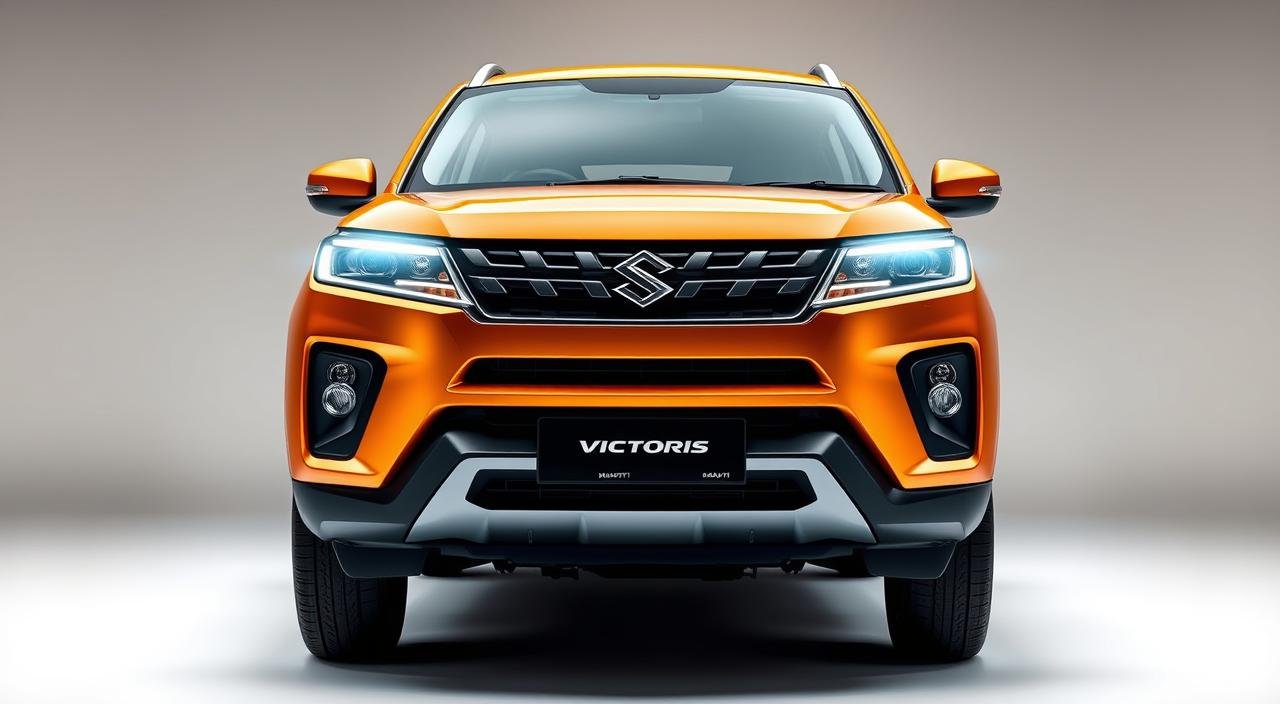
Oct
On September 3, 2025, Maruti made a big splash in the Indian car market. The Maruti Victoris First Look shows off a new compact SUV India has been eager for. It’s a big change for the brand.
This SUV sits between the Brezza and the Grand Vitara in Maruti’s lineup. It brings new features like Level-2 ADAS and a special CNG tank. These are big steps for India’s top car maker.
The Victoris is all about safety. It got perfect 5-star ratings in crash tests. This sets a high standard for safety in compact SUVs in India.
The design is modern, with cool LED lights and 18-inch alloy wheels. You can pick from 10 colors, including three dual-tone options. It looks and feels premium.
Key Takeaways
- First Maruti vehicle to feature Level-2 ADAS technology
- Revolutionary underbody CNG tank design for better space utilization
- Perfect 5-star safety ratings from both Bharat NCAP and Global NCAP
- Advanced pixel LED DRL technology with connected lighting design
- Premium 18-inch dual-tone alloy wheels as standard
- Ten color options including three dual-tone combinations
- Positioned between Brezza and Grand Vitara in Maruti’s lineup
Introduction to the Maruti Victoris
The car market in India is changing fast with Maruti’s new Victoris. This car marks Maruti’s big step into the luxury SUV world. Now, people can see top-notch features and new tech at their local dealerships.
Overview of Maruti’s Legacy
Maruti has been a big name in India’s car world for 40 years. They made cars like the 800, Alto, and Swift that everyone knew. These cars were known for being good on gas and giving great value.
Maruti’s dealerships are everywhere in India. They have over 2,500 places in 1,900 cities. This made it easy for many families to own a car.
Why the Victoris is Significant
The Victoris brings premium features never seen before to Arena showrooms. It has:
- 8-speaker Infinity sound system with Dolby Atmos
- Powered tailgate with gesture control
- Ventilated front seats
- 5-star safety rating capabilities
This move shows Maruti’s dedication to meeting new customer needs. The Victoris offers luxury without breaking the bank, thanks to the Arena dealerships.
First-Ever SUV from Maruti
The Victoris is a big deal for Maruti as its first SUV for Arena dealerships. This First Look shows how Maruti has changed in the compact SUV market. It now faces tough competition with a car that gets great reviews, scoring 4.7 out of 5.
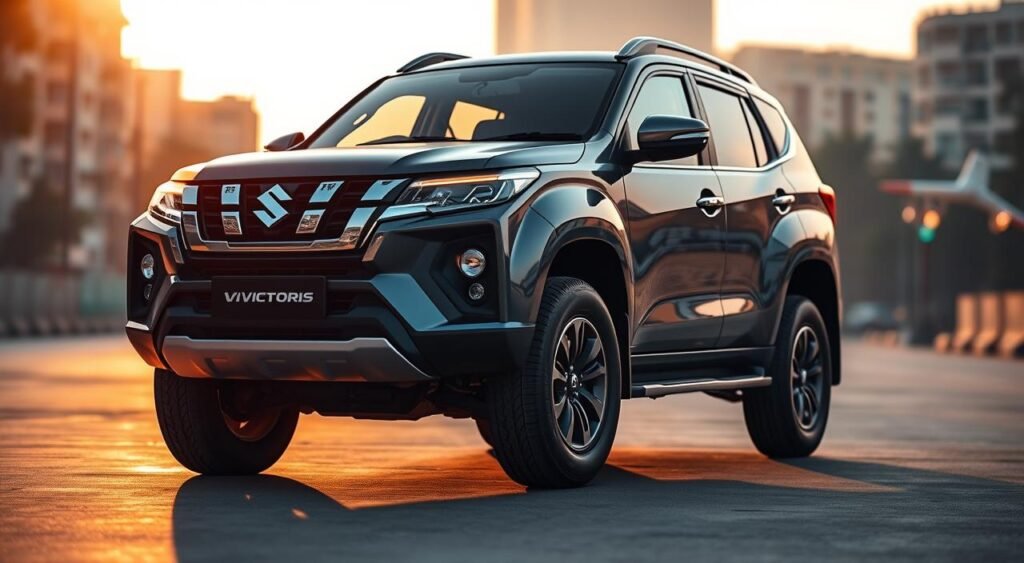
The Journey from Hatchbacks to SUVs
Maruti’s story is quite interesting. It started with affordable hatchbacks like the Alto and Swift. These cars were all over Indian roads for years. Now, the Victoris is a big leap into the premium SUV world.
This SUV has strong hybrid tech and advanced safety features. These were missing from Maruti’s Arena showrooms before. It shows Maruti listened to what customers wanted.
Market Expectations and Consumer Interest
The compact SUV market is very competitive. The Victoris goes up against big names like:
- Hyundai Creta
- Kia Seltos
- Tata Curvv
- Honda Elevate
- MG Astor
- Volkswagen Taigun
- Skoda Kushaq
Reviews say the Victoris stands out for its safety tech, fuel efficiency, and luxury features. People love how these are all in one car. It looks like Maruti has really hit the mark with this SUV.
Design Innovations in the Victoris
The Maruti Victoris is a standout in the Indian SUV market. It combines modern looks with practical features. This new SUV shows Maruti Suzuki’s commitment to style and value.
Exterior Styling and Features
The Victoris has a bold exterior styling that makes it unique. Its front has a sleek grille and connected LED daytime running lights. This creates a distinctive look that grabs attention on Indian roads.
- Connected LED tail lights with pixelated patterns
- 17-18 inch alloy wheels for enhanced road presence
- Silver roof rails and floating roofline design
- Squared wheel arches for a muscular stance
- Overall length 15mm longer than Grand Vitara
Interior Comfort and Tech Integration
The interior of this new SUV is a mix of luxury and advanced interior technology. You can pick from dual-tone black and ivory or all-black, with champagne gold accents. The dashboard has a 10.1-inch touchscreen with apps and updates.
A 10.25-inch digital driver display shows important info at a glance. The interior is also enhanced with 64-color ambient lighting and premium leatherette upholstery.
Performance Highlights of the Victoris
The Maruti Victoris offers a strong performance that goes beyond what’s expected. It comes with three engine options, fitting different driving styles. At the same time, it keeps fuel efficiency high, setting a new standard in its class.
Engine Specifications and Variants
The Victoris has impressive engine specifications in its variants. The base model has a 1.5-liter mild hybrid engine, making 103 PS and 139 Nm of torque. It comes with a 5-speed manual or 6-speed automatic transmission.
The strong hybrid version boosts performance with 116 PS and 141 Nm. It uses an e-CVT transmission for smooth power transfer.
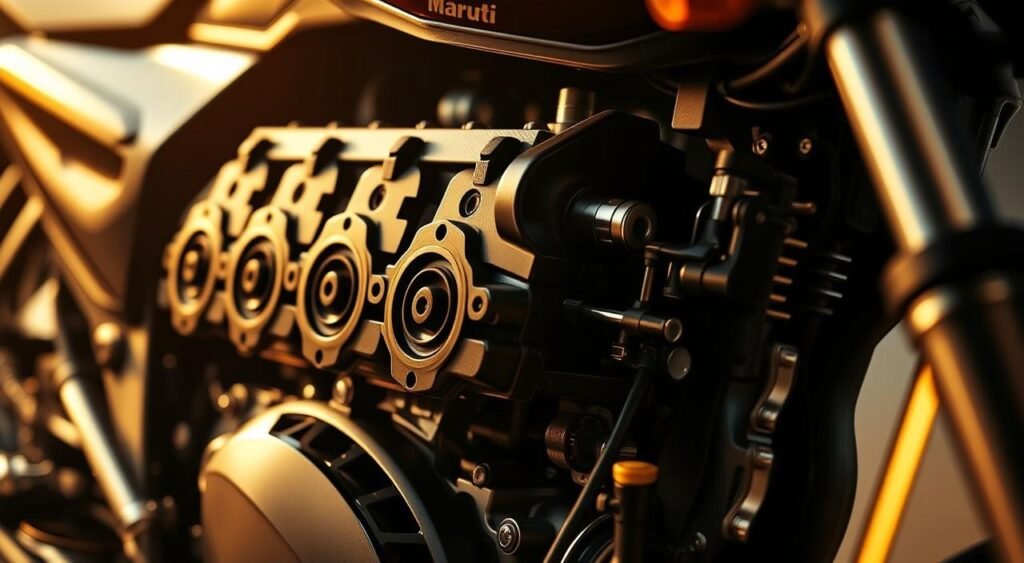
The CNG variant is perfect for those who care about the environment. It makes 88 PS and 121.5 Nm, and it’s very fuel-efficient at 27.02-27.2 km/kg. Each engine shows Maruti’s dedication to combining power with economy.
Driving Experience and Handling
The Victoris makes a great first impression as a smooth ride. The AWD version has special driving modes like auto, snow, sport, and lock. These modes change how the SUV handles, fitting the road and the driver’s mood.
With 210mm ground clearance, the Victoris can handle tough terrain well. It also cruises smoothly on highways. The strong hybrid version gets an amazing 28.65 kmpl, showing that performance and fuel efficiency can go hand in hand. The CNG tank is smartly placed, keeping cargo space large, even more than the Grand Vitara’s 373-liter capacity.
Advanced Safety Features
The Maruti Victoris leads in passenger safety with top-notch features. It meets international safety standards, making it one of the safest SUVs in India. It has earned high NCAP ratings, showing its commitment to safety.
Breakdown of Safety Technologies
The Maruti Victoris has many safety features to protect everyone inside. It has six airbags for all passengers. Its advanced braking system, with ABS and EBD, helps stop quickly in emergencies.
The ADAS package adds to the driving experience with Level-2 autonomous features. It includes:
- Autonomous emergency braking for collision prevention
- Adaptive cruise control for highway comfort
- Lane keep assist to prevent unintended lane departures
- Blind spot detection with camera assistance
- 360-degree camera system for complete visibility
More safety features help control the vehicle in tough situations. Hill hold assist stops rollback on hills. AWD models have hill descent control. The electronic parking brake with auto hold is convenient for automatics.
Rating and Testing Standards
The Maruti Victoris got 5-star NCAP ratings in Bharat and Global NCAP tests. It’s a big achievement, making it the second Maruti to reach this mark. The tests checked frontal, side, and pedestrian protection, and the Victoris did great in all areas.
The Infotainment System
The new Maruti SUV brings a new level of fun to driving with its infotainment system. It has a huge 10.1-inch touchscreen display that changes the game. This big step forward shows the brand’s commitment to modern connectivity features.

Features of the Multimedia Interface
The touchscreen interface makes the dashboard feel like a smartphone. It supports wireless Android Auto and Apple CarPlay, so you don’t see any cables. You can also get popular apps from a built-in store, making long trips fun.
Voice control through Alexa makes things even easier. You can control music, navigation, and calls just by talking. The 8-speaker Infinity sound system with Dolby Atmos technology takes the audio quality to new heights.
The digital driver display changes with the trim level. Strong hybrid models get a 10.25-inch fully digital cluster. Other models have a 4.2-inch TFT screen. And the top models even have a head-up display for better safety.
Connectivity Options Available
Charging your devices is easy with multiple USB-C ports that support 60W fast charging. There’s also a wireless phone charger that keeps your phone cool. You’ll find traditional Type-A ports and 12V sockets in the front and rear for older devices. These features make the Maruti SUV perfect for today’s tech needs.
Environmental Considerations
The Victoris is a big step for Maruti in making cars better for the planet. It has eco-friendly features that are leading the way in India. It’s designed to be both high-tech and easy to use every day.
Fuel Efficiency Ratings
The Victoris is great at saving fuel, no matter the model. It’s made to go far on a little gas while keeping performance up. The hybrid version is the best, getting up to 28.65 kilometers per liter.
The mild hybrid models do well too, getting between 19.07 and 21.18 kilometers per liter. This depends on the transmission you choose.
| Variant Type | Fuel Efficiency | Transmission |
|---|---|---|
| Strong Hybrid | 28.65 km/l | e-CVT |
| Mild Hybrid MT | 21.18 km/l | Manual |
| Mild Hybrid AT | 19.07 km/l | Automatic |
| CNG Variant | 27.02-27.2 km/kg | Manual |
Hybrid and Electric Options
The Victoris is the first in Maruti’s Arena line to use hybrid technology. It has a strong hybrid system with an e-CVT for smooth power and less pollution. The mild hybrids come with manual or automatic transmissions.
It also has a special CNG tank design. This lets the CNG versions get great mileage, from 27.02 to 27.2 kilometers per kilogram. All models meet strict emission standards, and hybrids cut down carbon emissions a lot.
Maruti’s Approach to Sustainability
The new SUV from Maruti shows the brand’s commitment to the environment. It uses innovative design and manufacturing to reduce environmental impact. Maruti’s efforts set new standards for responsible car production in India.
Use of Eco-Friendly Materials
The Victoris uses eco-friendly materials in its construction. Its interior has soft-touch leatherette trims instead of real leather. This choice cuts down on animal use and chemical processing needed for leather.
Lightweight construction is key in the Victoris’s design. It makes the car lighter without losing strength. This design boosts fuel efficiency and cuts down on materials needed to make the car.
Carbon Footprint Reduction Goals
Maruti aims to reduce emissions with advanced powertrains. The strong hybrid system gets up to 28.65 kilometers per liter. CNG models get 27.02 to 27.2 kilometers per kilogram, thanks to cleaner technology.
Maruti’s factories work hard to reduce waste and save energy. The CNG tank design is space-efficient and meets green goals. These steps show how the Victoris balances performance with caring for the planet.
Competitive Analysis
The Maruti Victoris enters a crowded mid-size SUV segment. Market positioning is key here. Priced between Rs.10.50-19.99 Lakh, it aims to challenge the big names. Let’s see how it stacks up in this competitive field.
How Victoris Stacks Up Against Rivals
The Victoris has some impressive features. It has 5-star safety ratings from Bharat and Global NCAP. This puts it ahead of many rival SUVs.
Its hybrid variant gets an amazing 28.65 kmpl. This beats most rivals in fuel efficiency.
Higher variants come with Level-2 ADAS as standard. This is advanced safety tech usually found in more expensive cars. Features like the underbody CNG tank and gesture-controlled tailgate make a strong first impression.
Key Market Competitors
The Victoris faces tough competition from well-known brands:
- Hyundai Creta (Rs.11.11-20.92 Lakh)
- Kia Seltos (Rs.11.19-20.56 Lakh)
- Honda Elevate
- MG Astor
- Volkswagen Taigun
- Skoda Kushaq
- Tata Curvv
Compared to the Grand Vitara (Rs.11.42-20.68 Lakh), the Victoris has similar engines. But it stands out with its Arena dealership and unique design. This market positioning helps Maruti reach different customers while keeping prices competitive.
Pricing Structure and Variants
The Maruti Victoris First Look shows competitive pricing with 21 variants across six trim levels. It starts at Rs.10.49 Lakh for the base LXi model with manual transmission. This makes the Victoris a great value in the SUV market.
Expected Pricing Range
The Victoris has variants for all budgets. The LXi trim starts at Rs.10.49 Lakh for manual and Rs.11.49 Lakh for CNG. The VXi variants cost between Rs.11.79 Lakh and Rs.13.35 Lakh.
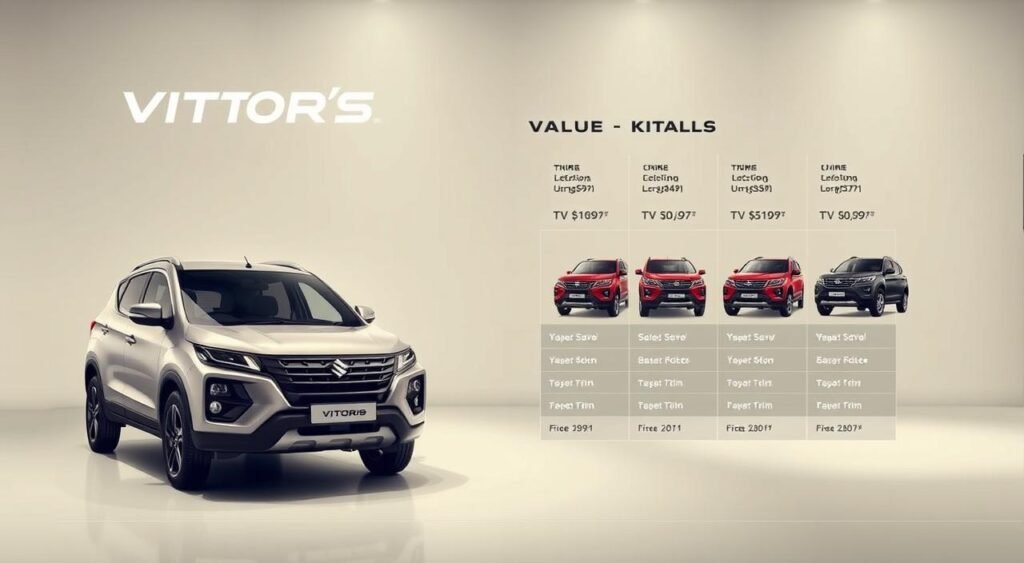
Premium ZXi variants cost from Rs.13.56 Lakh to Rs.18.38 Lakh. The top ZXi Plus models are priced from Rs.15.23 Lakh to Rs.19.98 Lakh. Hybrid variants start at Rs.16.37 Lakh for VXi and go up to Rs.18.38 Lakh for ZXi(O). AWD is only in ZXi Plus automatic variants, priced from Rs.18.63 Lakh to Rs.19.21 Lakh.
Price Comparison with Competitors
The Maruti Victoris First Look shows it’s priced to beat rivals. It offers better fuel efficiency and safety features. Base variants are cheaper than competitors by about Rs.1-2 Lakh, yet they have similar features.
Availability and Launch Plans
The Maruti SUV is set to hit the Indian market with a smart plan. This plan aims to make the Victoris easily available to customers. With production up and dealers ready, Maruti plans to make a big splash across the country.
Anticipated Launch Date
The launch date for the Maruti Victoris was September 15, 2025. This was a big moment for the brand. The unveiling on September 3, 2025, got everyone excited.
Dealers had time to get ready for the Victoris. They could prepare their stock and train their staff.
Right after the unveiling, customers could start booking their Victoris. They could book online or visit Arena dealerships. The booking fee was kept low, making it easy for people to reserve their SUV.
Regions and Dealerships
The Victoris is available everywhere thanks to Maruti’s huge network. With over 3,000 Arena dealerships across India, it’s easy to find one. This means people in big cities and small towns can get their hands on the new Maruti SUV.
Here are some key points about the Victoris’s availability:
- Immediate delivery for base and mid-spec variants
- Test drives available at all authorized outlets
- Priority allocation to major urban centers
- Pan-India service support from day one
Some high-spec models might have a wait list due to high demand. Export plans are being considered, but the focus is on the domestic market first.
Final Thoughts on the Victoris
The Maruti Victoris is a big step for the brand towards the premium segment. It combines safety, technology, and value in a new way. This shows Maruti’s effort to grow beyond what it’s known for.
Why This SUV is a Game-Changer
The Victoris is a game-changer for many reasons. It has a 5-star safety rating, setting a new standard. It also has Level-2 ADAS technology, making advanced driver help more accessible. Plus, its strong hybrid tech offers great fuel efficiency without losing performance.

Customers love the Victoris, giving it a 4.7 out of 5 rating. They say it’s safe and has great mileage. The CNG tank design is also a hit, showing off the brand’s engineering skills.
| Feature Category | Traditional Maruti | Victoris Innovation |
|---|---|---|
| Safety Rating | 3-4 stars | 5 stars |
| Technology Level | Basic infotainment | Level-2 ADAS |
| Fuel Options | Petrol/CNG | Strong Hybrid + CNG |
| Market Position | Budget-friendly | Premium value |
Future Implications for Maruti Suzuki
The Victoris’ success means big changes for Maruti. Arena showrooms will now offer premium features, like those at Nexa. This shows Maruti is moving towards advanced technologies while keeping prices low.
This move into the premium segment changes how people see the brand. Future models will likely have better safety, hybrid engines, and connected car tech. The Victoris shows Indian buyers want smart features without breaking the bank, changing how cars are made.
Call to Action
The Maruti Victoris is a big step for India’s top car maker. It’s an SUV with features never seen before in Maruti. It has advanced hybrid powertrains and all-wheel drive, setting new standards.
Car buyers looking for their next ride should check out the Victoris. You can find it at your nearest Maruti dealerships.
Encouraging Readers to Stay Tuned
The Victoris launch is just the start for Maruti Suzuki’s SUV lineup. Expect updates on features, variants, and booking soon. More details on the hybrid system and ADAS tech will come out.
Interested buyers can sign up on the Maruti Suzuki website. This way, they’ll get the latest news on pricing and when to buy.
Visiting Dealerships for a First-Hand Experience
Arena dealerships across India are now open for test drives. You can try out the hybrid system and see the 10 color options. Sales consultants will show you the safety and infotainment features.
There’s high demand for the AWD and hybrid variants. Visiting dealerships early is key to get your preferred model. The online configurator lets you pick your specs before your test drive.
FAQ
What makes the Maruti Victoris different from other Maruti SUVs?
The Maruti Victoris is a top SUV for Arena dealerships, between the Brezza and Grand Vitara. It has Level-2 ADAS, an underbody CNG tank, and 5-star safety ratings. It also has premium features like an 8-speaker sound system and ventilated seats, all firsts for Arena.
What are the engine options available in the Maruti Victoris?
The Victoris has three engine options: a 1.5-litre mild hybrid, a 1.5-litre strong hybrid, and a 1.5-litre CNG variant. You can choose from a 5-speed MT, 6-speed AT, or e-CVT for the strong hybrid. The AWD variant comes with a 6-speed AT and multi-drive modes.
How much does the Maruti Victoris cost?
The Maruti Victoris starts at Rs.10.49 Lakh and goes up to Rs.19.99 Lakh. It comes in 21 variants across 6 trim levels. The base LXi starts at Rs.10.49 Lakh, and the top ZXi Plus variants cost Rs.15.23-19.98 Lakh.
What is the fuel efficiency of the Maruti Victoris?
The Victoris has great fuel efficiency. The strong hybrid gets 28.65 kmpl. Mild hybrids get 19.07-21.18 kmpl, and CNG variants get 27.02-27.2 km/kg. The CNG tank design also saves space.
What safety features does the Maruti Victoris offer?
The Victoris got 5-star ratings in Bharat NCAP and Global NCAP tests. It has 6 airbags, ABS with EBD, and ESC. It also has a 360-degree camera and all-wheel disc brakes.
FAQ
What makes the Maruti Victoris different from other Maruti SUVs?
The Maruti Victoris is a top SUV for Arena dealerships, between the Brezza and Grand Vitara. It has Level-2 ADAS, an underbody CNG tank, and 5-star safety ratings. It also has premium features like an 8-speaker sound system and ventilated seats, all firsts for Arena.
What are the engine options available in the Maruti Victoris?
The Victoris has three engine options: a 1.5-litre mild hybrid, a 1.5-litre strong hybrid, and a 1.5-litre CNG variant. You can choose from a 5-speed MT, 6-speed AT, or e-CVT for the strong hybrid. The AWD variant comes with a 6-speed AT and multi-drive modes.
How much does the Maruti Victoris cost?
The Maruti Victoris starts at Rs.10.49 Lakh and goes up to Rs.19.99 Lakh. It comes in 21 variants across 6 trim levels. The base LXi starts at Rs.10.49 Lakh, and the top ZXi Plus variants cost Rs.15.23-19.98 Lakh.
What is the fuel efficiency of the Maruti Victoris?
The Victoris has great fuel efficiency. The strong hybrid gets 28.65 kmpl. Mild hybrids get 19.07-21.18 kmpl, and CNG variants get 27.02-27.2 km/kg. The CNG tank design also saves space.
What safety features does the Maruti Victoris offer?
The Victoris got 5-star ratings in Bharat NCAP and Global NCAP tests. It has 6 airbags, ABS with EBD, and ESC. It also has a 360-degree camera and all-wheel disc brakes.
When will the Maruti Victoris be available for purchase?
FAQ
What makes the Maruti Victoris different from other Maruti SUVs?
The Maruti Victoris is a top SUV for Arena dealerships, between the Brezza and Grand Vitara. It has Level-2 ADAS, an underbody CNG tank, and 5-star safety ratings. It also has premium features like an 8-speaker sound system and ventilated seats, all firsts for Arena.
What are the engine options available in the Maruti Victoris?
The Victoris has three engine options: a 1.5-litre mild hybrid, a 1.5-litre strong hybrid, and a 1.5-litre CNG variant. You can choose from a 5-speed MT, 6-speed AT, or e-CVT for the strong hybrid. The AWD variant comes with a 6-speed AT and multi-drive modes.
How much does the Maruti Victoris cost?
The Maruti Victoris starts at Rs.10.49 Lakh and goes up to Rs.19.99 Lakh. It comes in 21 variants across 6 trim levels. The base LXi starts at Rs.10.49 Lakh, and the top ZXi Plus variants cost Rs.15.23-19.98 Lakh.
What is the fuel efficiency of the Maruti Victoris?
The Victoris has great fuel efficiency. The strong hybrid gets 28.65 kmpl. Mild hybrids get 19.07-21.18 kmpl, and CNG variants get 27.02-27.2 km/kg. The CNG tank design also saves space.
What safety features does the Maruti Victoris offer?
The Victoris got 5-star ratings in Bharat NCAP and Global NCAP tests. It has 6 airbags, ABS with EBD, and ESC. It also has a 360-degree camera and all-wheel disc brakes.
How does the Maruti Victoris compare to competitors like Hyundai Creta and Kia Seltos?
FAQ
What makes the Maruti Victoris different from other Maruti SUVs?
The Maruti Victoris is a top SUV for Arena dealerships, between the Brezza and Grand Vitara. It has Level-2 ADAS, an underbody CNG tank, and 5-star safety ratings. It also has premium features like an 8-speaker sound system and ventilated seats, all firsts for Arena.
What are the engine options available in the Maruti Victoris?
The Victoris has three engine options: a 1.5-litre mild hybrid, a 1.5-litre strong hybrid, and a 1.5-litre CNG variant. You can choose from a 5-speed MT, 6-speed AT, or e-CVT for the strong hybrid. The AWD variant comes with a 6-speed AT and multi-drive modes.
How much does the Maruti Victoris cost?
The Maruti Victoris starts at Rs.10.49 Lakh and goes up to Rs.19.99 Lakh. It comes in 21 variants across 6 trim levels. The base LXi starts at Rs.10.49 Lakh, and the top ZXi Plus variants cost Rs.15.23-19.98 Lakh.
What is the fuel efficiency of the Maruti Victoris?
The Victoris has great fuel efficiency. The strong hybrid gets 28.65 kmpl. Mild hybrids get 19.07-21.18 kmpl, and CNG variants get 27.02-27.2 km/kg. The CNG tank design also saves space.
What safety features does the Maruti Victoris offer?
The Victoris got 5-star ratings in Bharat NCAP and Global NCAP tests. It has 6 airbags, ABS with EBD, and ESC. It also has a 360-degree camera and all-wheel disc brakes.
What are the dimensions and seating capacity of the Maruti Victoris?
FAQ
What makes the Maruti Victoris different from other Maruti SUVs?
The Maruti Victoris is a top SUV for Arena dealerships, between the Brezza and Grand Vitara. It has Level-2 ADAS, an underbody CNG tank, and 5-star safety ratings. It also has premium features like an 8-speaker sound system and ventilated seats, all firsts for Arena.
What are the engine options available in the Maruti Victoris?
The Victoris has three engine options: a 1.5-litre mild hybrid, a 1.5-litre strong hybrid, and a 1.5-litre CNG variant. You can choose from a 5-speed MT, 6-speed AT, or e-CVT for the strong hybrid. The AWD variant comes with a 6-speed AT and multi-drive modes.
How much does the Maruti Victoris cost?
The Maruti Victoris starts at Rs.10.49 Lakh and goes up to Rs.19.99 Lakh. It comes in 21 variants across 6 trim levels. The base LXi starts at Rs.10.49 Lakh, and the top ZXi Plus variants cost Rs.15.23-19.98 Lakh.
What is the fuel efficiency of the Maruti Victoris?
The Victoris has great fuel efficiency. The strong hybrid gets 28.65 kmpl. Mild hybrids get 19.07-21.18 kmpl, and CNG variants get 27.02-27.2 km/kg. The CNG tank design also saves space.
What safety features does the Maruti Victoris offer?
The Victoris got 5-star ratings in Bharat NCAP and Global NCAP tests. It has 6 airbags, ABS with EBD, and ESC. It also has a 360-degree camera and all-wheel disc brakes.
What infotainment features does the Maruti Victoris offer?
FAQ
What makes the Maruti Victoris different from other Maruti SUVs?
The Maruti Victoris is a top SUV for Arena dealerships, between the Brezza and Grand Vitara. It has Level-2 ADAS, an underbody CNG tank, and 5-star safety ratings. It also has premium features like an 8-speaker sound system and ventilated seats, all firsts for Arena.
What are the engine options available in the Maruti Victoris?
The Victoris has three engine options: a 1.5-litre mild hybrid, a 1.5-litre strong hybrid, and a 1.5-litre CNG variant. You can choose from a 5-speed MT, 6-speed AT, or e-CVT for the strong hybrid. The AWD variant comes with a 6-speed AT and multi-drive modes.
How much does the Maruti Victoris cost?
The Maruti Victoris starts at Rs.10.49 Lakh and goes up to Rs.19.99 Lakh. It comes in 21 variants across 6 trim levels. The base LXi starts at Rs.10.49 Lakh, and the top ZXi Plus variants cost Rs.15.23-19.98 Lakh.
What is the fuel efficiency of the Maruti Victoris?
The Victoris has great fuel efficiency. The strong hybrid gets 28.65 kmpl. Mild hybrids get 19.07-21.18 kmpl, and CNG variants get 27.02-27.2 km/kg. The CNG tank design also saves space.
What safety features does the Maruti Victoris offer?
The Victoris got 5-star ratings in Bharat NCAP and Global NCAP tests. It has 6 airbags, ABS with EBD, and ESC. It also has a 360-degree camera and all-wheel disc brakes.
Is the Maruti Victoris available with AWD?
FAQ
What makes the Maruti Victoris different from other Maruti SUVs?
The Maruti Victoris is a top SUV for Arena dealerships, between the Brezza and Grand Vitara. It has Level-2 ADAS, an underbody CNG tank, and 5-star safety ratings. It also has premium features like an 8-speaker sound system and ventilated seats, all firsts for Arena.
What are the engine options available in the Maruti Victoris?
The Victoris has three engine options: a 1.5-litre mild hybrid, a 1.5-litre strong hybrid, and a 1.5-litre CNG variant. You can choose from a 5-speed MT, 6-speed AT, or e-CVT for the strong hybrid. The AWD variant comes with a 6-speed AT and multi-drive modes.
How much does the Maruti Victoris cost?
The Maruti Victoris starts at Rs.10.49 Lakh and goes up to Rs.19.99 Lakh. It comes in 21 variants across 6 trim levels. The base LXi starts at Rs.10.49 Lakh, and the top ZXi Plus variants cost Rs.15.23-19.98 Lakh.
What is the fuel efficiency of the Maruti Victoris?
The Victoris has great fuel efficiency. The strong hybrid gets 28.65 kmpl. Mild hybrids get 19.07-21.18 kmpl, and CNG variants get 27.02-27.2 km/kg. The CNG tank design also saves space.
What safety features does the Maruti Victoris offer?
The Victoris got 5-star ratings in Bharat NCAP and Global NCAP tests. It has 6 airbags, ABS with EBD, and ESC. It also has a 360-degree camera and all-wheel disc brakes.

Oct
The car world saw a big moment when Maruti Suzuki Victoris got 5 stars in BNCAP crash tests. This is a big win for India’s biggest car maker. It shows they are leading in making cars safe.
The Victoris did great in many safety tests. It got 33.72 out of 34 points for keeping adults safe. This shows it’s very strong.
It also did well in tests for keeping kids safe, getting 41 out of 49 points. Its body is very stable, making it safe for everyone.
In frontal crash tests, the SUV got 15.807 out of 16 points. It protected the driver’s head, neck, and pelvis well. The chest and right tibia got good protection too.
Side impact tests also showed great results, with 15.913 out of 16 points. The BNCAP crash test showed it protected most body areas well. It stayed safe in many crash scenarios.
Key Takeaways
- First Maruti Suzuki model to achieve 5-star Global NCAP rating
- Outstanding Adult Occupant Protection score of 33.72/34 points
- Strong Child Occupant Protection rating with 41/49 points
- Stable bodyshell integrity confirmed through rigorous testing
- Frontal crash test score of 15.807/16 demonstrates robust safety design
- Side impact protection rated at 15.913/16 points
- Sets new safety benchmark for Indian automotive market
Overview of Maruti Suzuki Victoris
The Maruti Suzuki Victoris is a big step for Indian car makers. It shows they can make cars that are safe and perform well. This SUV is at the top of Maruti’s line and is sold through their Arena dealerships.
It recently passed a crash test, proving Indian cars can meet global safety standards. This is a big win for Maruti Suzuki.
Key Features of the Victoris
The Maruti Suzuki Victoris has many safety features. These include:
- Six airbags for complete protection
- Electronic Stability Control (ESC) and traction control
- ABS with EBD for better braking
- Hill hold assist for steep hills
- ISOFIX child seat anchor points
- Three-point seatbelts with reminders for everyone
- Rear parking sensors and overspeed alerts
Higher versions of the Victoris add more safety features. These include a 360-degree camera system and electronic parking brake. It also has Level 2 ADAS technology. The Victoris comes in three types: petrol, hybrid, and CNG.
Target Audience and Market
The Victoris is for city families and young professionals. It offers style, safety, and good fuel use. Its price and features make it appealing to new SUV buyers and those moving up from smaller cars.
Competitors in the Segment
The Victoris has tough competition in the midsize SUV market. It goes up against the Hyundai Creta, Kia Seltos, Tata Curvv, Skoda Kushaq, and Volkswagen Taigun. Each has its own strengths. But the Victoris stands out for its focus on vehicle safety and Maruti’s wide service network.
Importance of Safety Ratings in Cars
Car safety is now a key factor in buying cars in India. Modern cars go through tough tests to get their Safety Rating. A 5 Star rating means they offer the best protection in accidents.
These ratings give buyers clear info on how safe a car is. They show how well a car keeps its passengers safe during crashes.
Understanding BNCAP Standards
The Bharat New Car Assessment Program (BNCAP) checks cars through detailed crash tests. Cars face front and side impacts at certain speeds. This tests how well they protect people inside.
A 5 Star Safety Rating means a car does well in:
- Adult occupant protection
- Child safety measures
- Safety assist technologies
- Pedestrian protection features
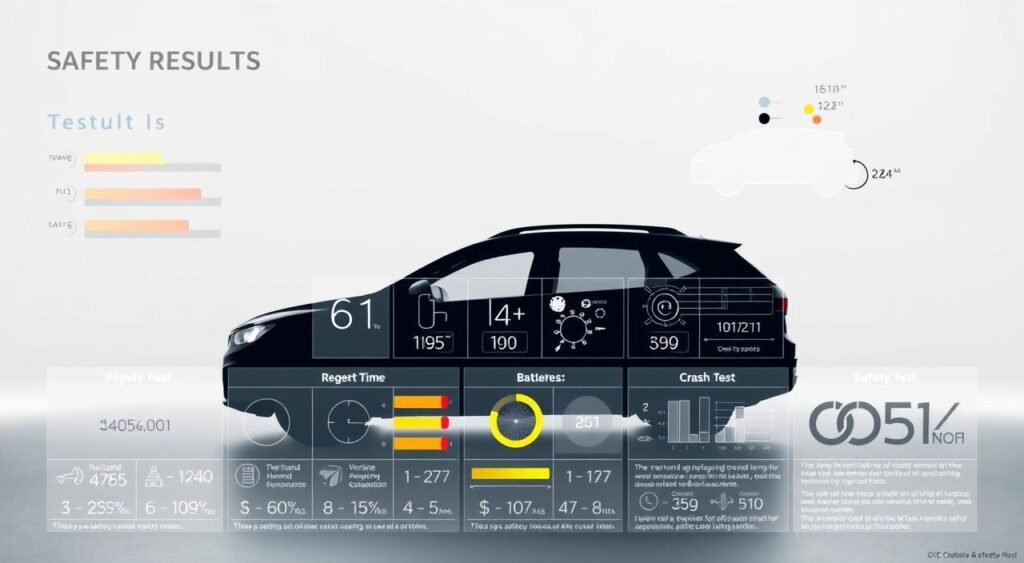
Each area gets a score, and these scores add up to the final rating. Cars with 5 Stars do great in all tests. They show top-notch engineering and safety design.
How Ratings Affect Consumer Choices
In India, car buyers focus more on safety. A car with a 5 Stars Safety Rating is more trusted. It might also cost more, but buyers are willing to pay for safety.
This trend affects more than just personal buyers. Companies that buy cars also look for high safety ratings. This pushes car makers to focus more on safety. It’s a win for everyone on the road.
Details of the BNCAP Crash Test
The Maruti Suzuki Victoris was tested by Global NCAP to get a 5-star safety rating. It went through many crash tests to check how safe it is for adults and kids. These tests help us know how safe a car is in real accidents.
Testing Methodology
The BNCAP crash test uses strict rules to get accurate results. It tests how a car does in a head-on crash and when hit from the side. It also checks how a car does when it slides into a pole.
Results Breakdown
The Victoris did very well in all crash tests. It got perfect scores for keeping kids safe. It did great in side impact tests, showing it’s safe all over.
| Test Category | Score Achieved | Maximum Score |
|---|---|---|
| Child Frontal Protection | 8 | 8 |
| Child Side Protection | 4 | 4 |
| CRS Installation | 12 | 12 |
| Vehicle Assessment | 5 | 13 |
Comparison with Other Vehicles
Compared to other cars in its class, the Victoris is a clear winner. Many cars in this price range don’t do as well in safety tests. But the Victoris got perfect scores, making it one of the safest cars in India.
Impact of 5-Star Rating on Sales
The link between crash test ratings and car sales is growing in India. A car’s top safety scores can sway buyer choices and its market standing. The Maruti Suzuki Victoris Safety getting 5 Stars in crash tests is a big deal for its sales.
Anticipated Market Response
Experts think the Victoris’s safety win will draw a lot of interest. It got 5 Stars in BNCAP and is likely to do well in Global NCAP too. Dealers say they’re getting more calls after the safety news.
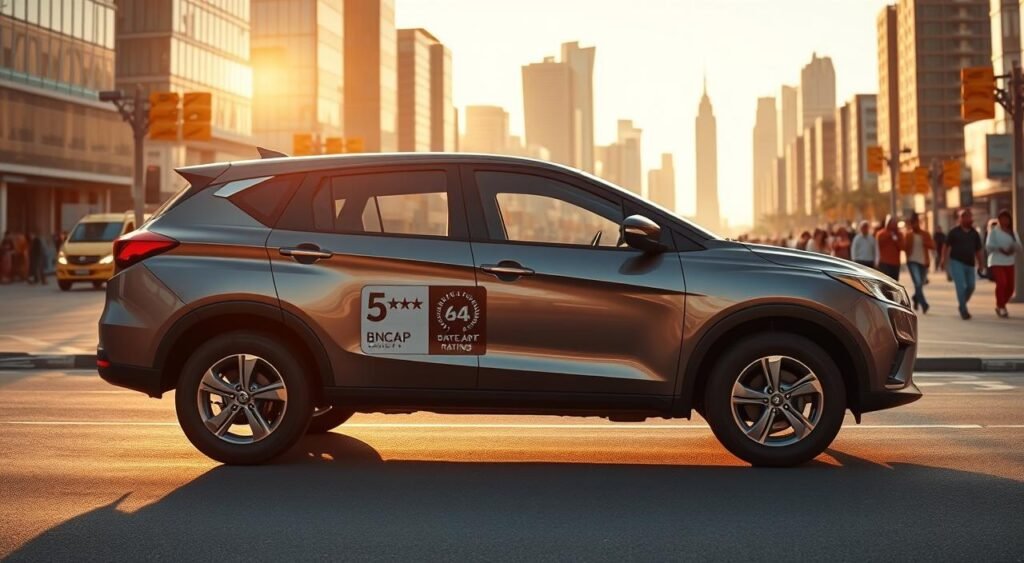
The Maruti Suzuki Victoris Safety win will likely pull in buyers who care about safety. In India, people now value safety as much as fuel efficiency and price.
Historical Context of Ratings and Sales
Looking back, safety ratings and sales in India show a clear link:
| Vehicle Model | Safety Rating | Sales Impact (First 6 Months) | Market Share Change |
|---|---|---|---|
| Tata Nexon | 5 Stars (2018) | +47% | +2.3% |
| Mahindra XUV300 | 5 Stars (2020) | +38% | +1.8% |
| Tata Altroz | 5 Stars (2020) | +42% | +1.5% |
| Maruti Suzuki Dzire | 5 Stars (2024) | +35% | +2.1% |
The Dzire’s success after getting 5 Stars shows Maruti’s focus on safety. This suggests the Victoris will see a boost in sales when it hits the market this month.
Consumer Reactions to the Rating
The Maruti Suzuki Victoris has excited many in India. Its 5-star rating in safety has raised the bar for cars in the country. This makes it a top choice for those looking for safety.
Feedback from Owners
Victoris owners are very happy with their choice. They love the car’s safety features. The six airbags in every model are a big hit with families.
People also talk about the car’s strong body in crash tests. Parents like the extra safety features in the higher models. These make them feel safer on the road.
Online Reviews and Discussions
Online, people are talking a lot about the Victoris’s safety. Social media is full of stories where the car’s safety helped avoid accidents. Or made injuries less severe.
| Review Platform | Average Rating | Key Praise Points |
|---|---|---|
| CarDekho | 4.6/5 | Build quality, safety features |
| CarWale | 4.5/5 | Crash test performance, airbag system |
| Team-BHP Forums | 4.7/5 | Structural integrity, safety technology |
Online, car lovers say safety is key for them. The Victoris shows Maruti Suzuki is listening to what people want. It’s a big step forward for the brand.
Maruti Suzuki’s Commitment to Safety
Maruti Suzuki is making a big push for safer cars. They use the latest tech and add lots of safety features. Their recent success in crash tests shows they’ve been working hard to make cars safer for everyone.
Innovations in Safety Technology
The Maruti Suzuki Victoris Safety package has some cool features. It has Electronic Stability Control (ESC) and traction control to stop skidding. It also has hill hold assist and ISOFIX child seat mounts on all models.
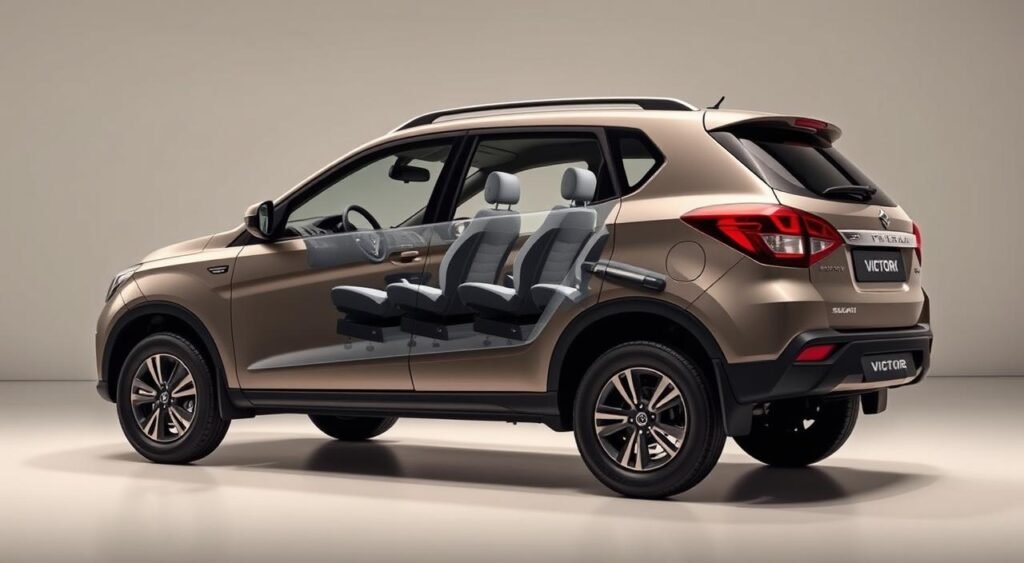
The top versions of the Victoris have advanced safety tech. This includes adaptive cruise control and lane keeping assist. It also has an electronic parking brake and a 360-degree camera for better visibility.
Previous Vehicles with High Safety Ratings
Maruti Suzuki has been getting better at making safe cars. The Dzire got a 5-star Global NCAP Safety Rating in November 2024. This was a big win for the brand.
| Model | Safety Rating | Year Tested | Key Safety Features |
|---|---|---|---|
| Dzire | 5 Stars | 2024 | 6 airbags, ESC, ABS |
| Brezza | 4 Stars | 2023 | Dual airbags, ABS, EBD |
| Baleno | 3 Stars | 2022 | Dual airbags, ABS |
This shows how Maruti Suzuki has grown in making cars safer. They’ve improved the car’s structure and added more safety features.
The Role of Crash Tests in Vehicle Development
Crash tests are key in making cars safer. They help car makers improve their designs. By testing cars, engineers find ways to make them safer for everyone.
Safety Features Being Developed
The Victoris is a top example of safe car design. Its bodyshell is very stable, getting high scores in tests. It did well in tests for adult safety, getting 15.807 out of 16 points.
Keeping kids safe is also a big focus. The Victoris got perfect scores in tests for child safety. It passed tests with 18-month and 3-year-old dummies in front and side crashes.
Continuous Improvement in Design
Crash tests help engineers make cars better. They look at how to improve things like crumple zones and airbags. The Victoris shows how years of testing can lead to a safer car.
| Test Type | Score Achieved | Maximum Points |
|---|---|---|
| Frontal Offset Deformable Barrier | 15.807 | 16.000 |
| Side Movable Deformable Barrier | 15.913 | 16.000 |
| Child Restraint Dynamic Score | 24.000 | 24.000 |
This careful testing makes cars safer over time. It helps make sure every new car is better than the last.
Regulatory Impact on Vehicle Design
Vehicle safety standards in India have changed a lot in recent years. The Maruti Suzuki Victoris shows how makers adjust their designs to meet new rules. These rules make cars safer while keeping prices and performance good.
Changes in Safety Regulations
India’s car safety rules changed a lot in 2019. Now, every new car must have:
- Dual front airbags
- ABS (Anti-lock Braking System)
- Rear parking sensors
- Speed alert system
- Seatbelt reminder
The Victoris goes beyond these rules by having six airbags in all models. This focus on safety helped it get a high Safety Rating in India and worldwide.
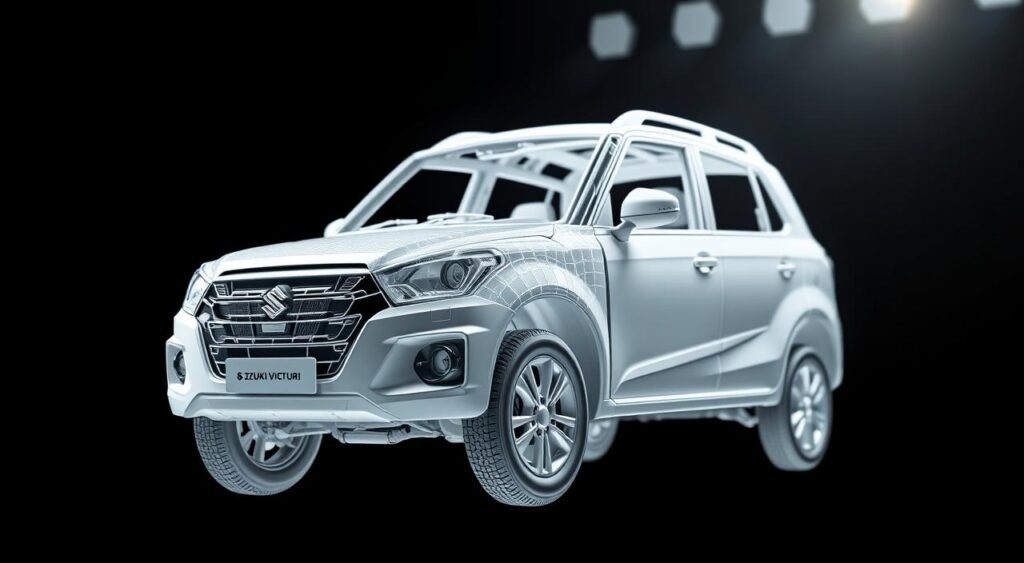
Future Implications for Manufacturers
The Victoris’s success in the BNCAP Crash Test raises the bar for the industry. Car makers are under pressure to meet or beat these standards. Companies that invest in safety tech get ahead in the Indian market.
Future rules will likely ask for better protection for pedestrians and more advanced driver aids. Makers need to add these features early on, not just later. The Victoris shows it’s possible to be safe without making cars too expensive.
Future Outlook for Maruti Suzuki
The Maruti Suzuki Victoris getting 5 stars in BNCAP crash tests marks a big change for India’s top car maker. This achievement sets the stage for the company to change its market plans at home and abroad. The Victoris will be key to their big growth plans.
Upcoming Models and Innovations
Maruti Suzuki aims to add more safety features to all its cars after the Victoris’s success. They are working on new models with:
- Stronger bodies made with high-tensile steel
- Standard driver assistance systems (ADAS)
- Better airbags for more safety
- Smart tech for quick emergency help
The Victoris will help shape future cars from Maruti Suzuki, keeping safety high across all prices. Engineers are making these cars safer without making them too expensive, which is important for Indian buyers.
Expansion Plans in Global Markets
The Victoris’s 5 stars rating opens up new chances for Maruti Suzuki in global markets. They aim to grow in:
- Southeast Asia, where safety is key
- Africa, where people want reliable, safe cars
- Latin America, where safety is becoming more important
Maruti Suzuki will offer different engine options like petrol, hybrid, and CNG. This lets them tailor the Victoris to fit different markets while keeping safety at the top.
The Victoris’s Design and Engineering
The Maruti Suzuki Victoris is a big step forward in car design. It combines looks with top-notch engineering. Its strong structure is key to its great crash test results. This shows how good design helps keep passengers safe.
Aesthetic Aspects and User Experience
The Victoris has a bold front grille and sleek LED headlamps. These improve visibility and safety. Its body shape cuts down wind resistance while staying strong.
The inside of the car focuses on clear views for the driver. It has controls that are easy to reach. This makes driving safer and more comfortable.
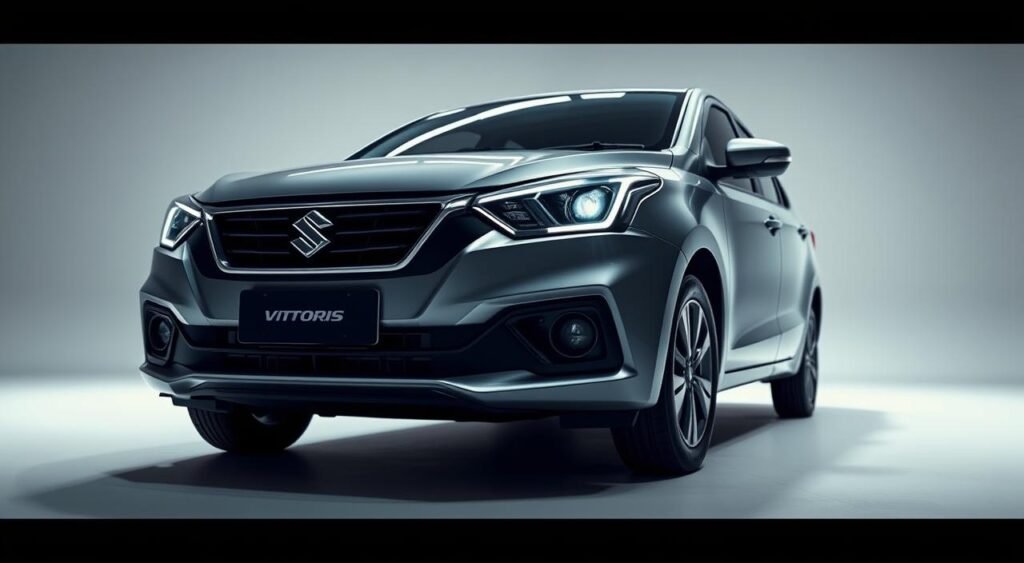
The cabin is made with premium materials to soak up shock in crashes. The dashboard is soft to the touch and helps protect against extra impacts.
Engineering Innovations Contributing to Safety
The Victoris’s safety is built into its design. It uses high-tensile steel in key spots. This creates zones that absorb shock before it reaches the people inside.
- Level 2 ADAS technology in higher variants
- 360-degree camera system for enhanced visibility
- Electronic parking brake with auto-hold function
- Reinforced door beams and side-impact protection
These features work together to protect important body areas in crashes. The Victoris shows Maruti Suzuki’s dedication to safety. It goes beyond what’s expected in the industry.
Community and Environmental Considerations
The car industry has a big challenge. It must balance being green with keeping drivers safe. The Maruti Suzuki Victoris shows it’s possible to do both well.
This car proves you can choose an eco-friendly vehicle. And you don’t have to give up safety for your family.
How Safety Ratings Influence Eco-Friendly Practices
When cars get high safety ratings, like the Victoris, it pushes makers to go green. The 5-star BNCAP rating shows that safe cars can also be eco-friendly.
This change affects the industry in many ways:
- Engineers use lighter materials that are strong
- Batteries in hybrids are placed to protect in crashes
- CNG tanks are installed safely
- Technologies that cut emissions work with safety features
Maruti Suzuki’s Sustainable Initiatives
The Victoris shows Maruti Suzuki’s dedication to green cars. It offers hybrid, CNG, and efficient petrol engines. Each one has the same safety features, so you’re always protected.
Some key green features are:
- Hybrid tech cuts fuel use by up to 40%
- CNG models reduce emissions but keep performance high
- Light materials make the car more efficient without losing safety
- Recyclable materials are used in the car’s interior and body
The Maruti Suzuki Victoris is a leader in safe, green cars. It helps communities breathe cleaner air and keeps families safe on the road.
Conclusion: The Significance of the 5-Star Rating
The Maruti Suzuki Victoris has earned a 5-star rating in the BNCAP crash test. This is a big win for the company. It shows the Victoris is one of the safest cars in its class.
The car’s Adult Occupant Protection score is 33.72 out of 34. Its Child Occupant Protection score is 41 out of 49. These scores are very high and meet global safety standards.
Summary of Key Points
The Victoris has six airbags, Electronic Stability Control, and advanced driver assistance systems. These features helped it get a 5-star rating in both BNCAP and Global NCAP tests. Now, it can compete with cars like the Hyundai Creta and Kia Seltos in safety.
This safety package shows Maruti Suzuki’s dedication to keeping drivers and passengers safe. It also meets the latest safety rules.
The Future of Maruti Suzuki Victoris in the Market
The 5-star rating will help the Victoris do well in both India and other countries. In India, people who care about safety look at crash test ratings when buying a car. The Victoris’s 5-star rating will make more people trust the car and want to buy it.
This success helps Maruti Suzuki grow in the competitive SUV market. It also sets new safety standards for cars.
FAQ
What safety ratings did the Maruti Suzuki Victoris achieve in crash tests?
The Maruti Suzuki Victoris got 5-star ratings in BNCAP and Global NCAP crash tests. It scored 33.72 out of 34 points for Adult Occupant Protection (AOP) and 41 out of 49 points for Child Occupant Protection (COP). This makes it Maruti Suzuki’s first car to score 5 stars in Global NCAP.
What safety features come standard in the Maruti Suzuki Victoris?
All Victoris variants have six airbags, electronic stability control (ESC), traction control, ABS with EBD, hill hold assist, and ISOFIX child seat anchor points. They also have 3-point seatbelts with reminders, rear parking sensors, and overspeed alerts. Higher variants add a 360-degree camera, electronic parking brake with auto hold, and Level 2 ADAS.
How did the Victoris perform in specific crash test scenarios?
In frontal offset deformable barrier tests, the Victoris scored 15.807/16 points. This shows good protection for the driver’s head, neck, pelvis, thighs, left tibia, and feet. The side movable deformable barrier test yielded 15.913/16 points. Child restraint system testing achieved perfect dynamic scores of 24/24 points.
What powertrains are available for the Maruti Suzuki Victoris?
The Victoris comes with petrol, hybrid, and CNG powertrains. All powertrains have the same high safety standards and features. This shows that environmental considerations don’t compromise occupant protection.
Which vehicles does the Maruti Suzuki Victoris compete against?
The Victoris competes in the midsize SUV segment. It faces off against the Maruti Grand Vitara, Toyota Hyryder, Kia Seltos, Hyundai Creta, Tata Curvv, Skoda Kushaq, and Volkswagen Taigun. Its dual 5-star safety ratings make it one of the safest options in this competitive segment.
How does the Victoris compare to other Maruti Suzuki models in terms of safety?
The Victoris is Maruti Suzuki’s first car to achieve 5 stars in both AOP and COP categories in Global NCAP. It follows the Dzire, which achieved a 5-star Global NCAP rating in November 2024. This shows Maruti’s enhanced commitment to safety standards.
What is the significance of the bodyshell integrity rating?
The Victoris’s bodyshell integrity was marked as stable during crash tests. This indicates the vehicle’s structure can withstand impacts effectively. This rating reflects advanced structural design and engineering excellence in the SUV’s safety architecture.
When will the Maruti Suzuki Victoris launch in India?
The Victoris is set to launch in India this month. The dual 5-star ratings are expected to boost both domestic sales and support Suzuki’s export plans for international markets.
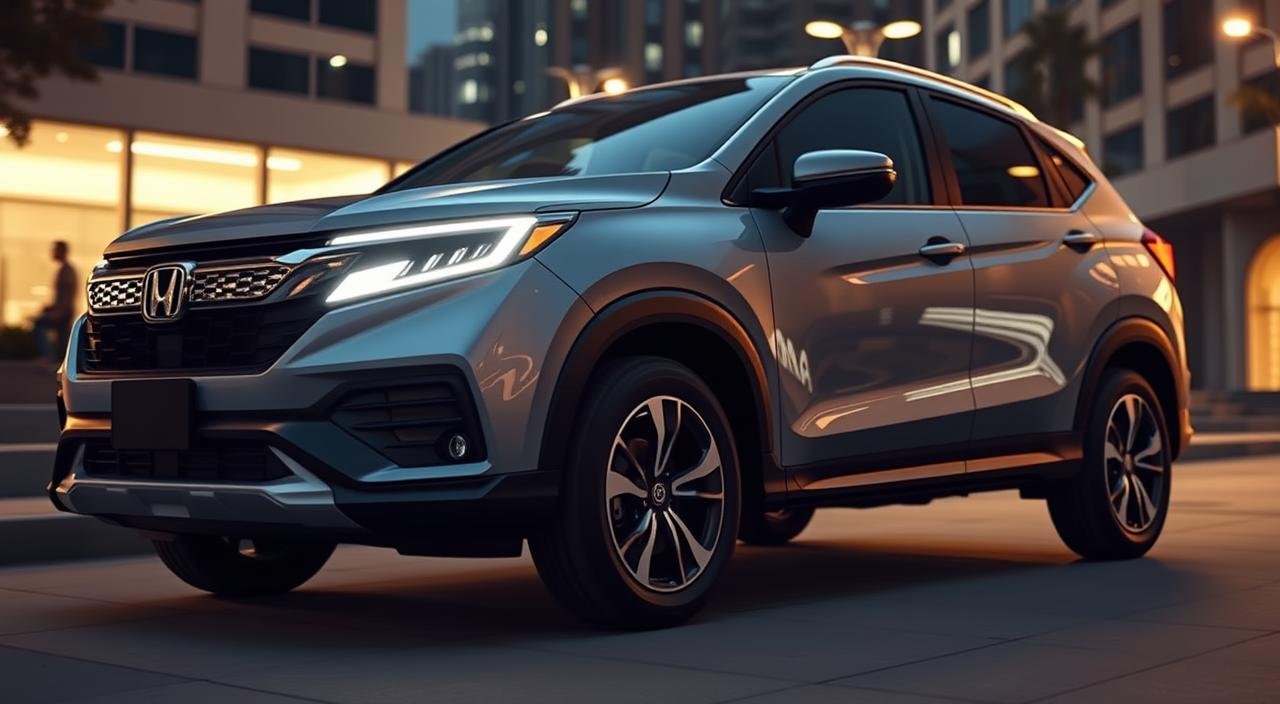
Oct
Can a few strategic updates turn an SUV into a top contender? Honda thinks yes with its updated Elevate, perfect for India’s festival season. The compact SUV market is tough, and Honda wants to boost the Elevate’s standing.
The updated Honda Elevate comes with new looks and better inside features. It keeps its strong 1.5-liter i-VTEC petrol engine. Prices start at Rs 11.91 lakh and go up to Rs 16.81 lakh (ex-showroom).
It has 458 liters of boot space and seats that fold 60:40. The 2650mm wheelbase makes the inside roomy. Plus, GST changes mean prices could drop by up to Rs 58,400 from September 22.
This review looks at if the Elevate’s updates make it worth considering. With new looks, useful features, and good prices, it’s a solid choice for city driving.
Key Takeaways
- Honda Elevate receives design and interior updates for the festival season
- Prices range from Rs 11.91 lakh to Rs 16.81 lakh with GST benefits up to Rs 58,400
- Retains the reliable 1.5-liter i-VTEC petrol engine
- Offers 458 liters of boot space with expandable 60:40 folding seats
- Measures 4312mm in length with a 2650mm wheelbase for spacious interiors
- Cosmetic updates aim to keep the compact SUV competitive in its segment
Overview of the Honda Elevate’s Latest Updates
The updated Honda Elevate comes with new design elements and modern features. These changes make driving more enjoyable. The SUV now has more customization options and premium touches across different variants.
The refreshed model tackles previous issues while keeping its competitive edge. It stands out in the mid-size SUV segment.
Key Changes in Design and Style
The Honda Elevate Bold Looks package introduces the striking Alpha-Bold Plus Grille option. This design makes the SUV’s front look more aggressive and bold. Crystal Black Pearl paint is now available across V, VX, and ZX variants, adding a sophisticated look.
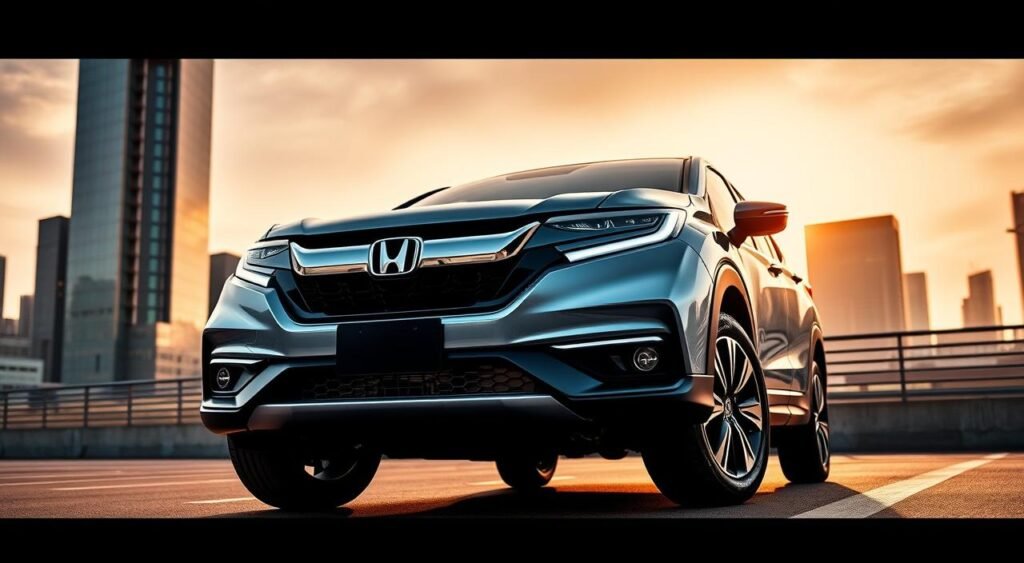
Enhanced Interior Features
The interior of the Honda Elevate has been improved for more comfort. The ZX grade has an elegant Ivory and Black two-tone cabin. It comes with leatherette seats and soft-touch inserts.
Lower V and VX grades have new all-black fabric seats with ivory accents. These replace the previous Shadow Beige upholstery for a sportier look.
New Technology Integrations
Technology upgrades have made the Elevate more convenient and comfortable. The ZX variant offers an optional 360-degree camera system for better visibility during parking. Seven-color ambient lighting lets drivers customize the cabin atmosphere.
These tech additions make the updated Elevate a modern, connected vehicle. It meets today’s expectations.
Bold Exterior Enhancements
The updated Honda Elevate stands out with its strong look and sleek design. It has a commanding presence on the road, making it stand out in the compact SUV market. The design changes highlight the SUV’s better performance while keeping it practical for Indian roads.
Revised Grille and Headlights
The front of the Honda Elevate has been completely revamped. It now has a large, upright grille with thick chrome accents. This bold grille, along with a flat bonnet, gives the SUV a powerful look. The angular headlights blend well with the grille, making the Elevate look modern.
Diamond-cut 17-inch alloy wheels add to the strong front design. Protective cladding also highlights the SUV’s rugged side.
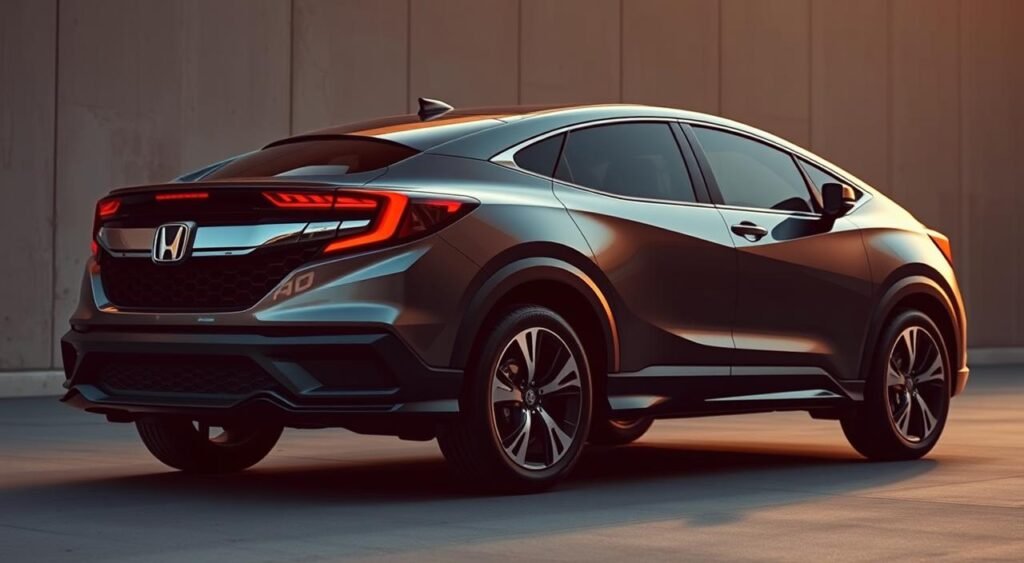
Sporty Body Lines and Colors
Sharp lines run along the side, creating a dynamic look from front to back. The thick C-pillar adds strength to the design. At the back, connected tail lamps with crisp edges make the SUV look wider and more stable.
Color options include:
- Single-tone finishes: Phoenix Orange Pearl, Obsidian Blue Pearl, Radiant Red Metallic, Platinum White Pearl, Golden Brown Metallic, Lunar Silver Metallic, and Meteoroid Gray Metallic
- Dual-tone options: Three combinations with Crystal Black Pearl roofs
- Black Editions: Base Black Edition with dark paint and silver accents, plus Signature Black Edition featuring complete black-out treatment including interior and Alpha-Bold Plus grille
Interior Comfort and Upgrades
The Honda Elevate Updated cabin offers a premium feel with top-notch materials and design. Soft-touch surfaces cover the dashboard, paired with wooden inserts and fine accents. These touches make every drive feel luxurious, whether in the city or on the highway.
Seating and Space Improvements
The seating in the Honda Elevate Features lineup has seen big upgrades. The seats are covered in plush fabric and are very supportive. The front seats, inspired by the Honda City, offer great cushioning and design.
Rear passengers get lots of legroom and headroom from the smart roof design. Big windows let in plenty of natural light. The seats recline for comfort on long trips. This design fits five adults comfortably.
Infotainment System Innovations
The 10.25-inch touchscreen infotainment system is the star of the show. It supports wireless Apple CarPlay and Android Auto, making it cable-free. The 7-inch semi-digital instrument cluster combines analog and digital smoothly.
- Electric sunroof with tilt and slide functions
- Pinch guard safety feature for sunroof operation
- Single-zone automatic climate control with intuitive controls
- 8-speaker sound system for immersive audio
The climate control system has a slim display with easy-to-use toggles and buttons. This design lets drivers adjust settings without taking their eyes off the road.
Performance and Efficiency
The Honda Elevate Performance shines with its well-tuned engine. It’s perfect for daily use and long trips. It’s built for Indian roads, giving you reliable power and great fuel economy.
Engine Options and Power Output
The Honda Elevate Review shows it has one engine for all models. A 1.5-liter four-cylinder engine makes 121 PS (119 bhp) at 6,600 rpm. It also has 145 Nm of torque at 4,300 rpm.

There are two transmission choices: a 6-speed manual or a CVT automatic. The engine provides steady power, making city driving easy. It also performs well when you need to speed up.
Fuel Economy Ratings
Fuel efficiency is a key feature of the Honda Elevate Performance. The ARAI-certified figures are impressive:
| Transmission Type | ARAI Mileage | Real-World Average |
|---|---|---|
| 6-Speed Manual | 15.31 kmpl | 14.0 kmpl |
| CVT Automatic | 16.92 kmpl | 14.94 kmpl |
In the city, you get about 10 kmpl with AC and 12 kmpl without. On highways, it’s 16 kmpl with AC on. The 220mm ground clearance helps it handle rough roads well, without losing fuel efficiency.
Safety Features Introduced
The updated Honda Elevate focuses on keeping passengers safe with top-notch safety tech. It has both active and passive safety systems for a secure ride. The Elevate’s specs include many airbags, advanced driver aids, and a strong build that scored well in crash tests.
Advanced Driver Assistance Systems
The Honda Sensing suite adds the latest in safety tech to the Elevate. It has a Collision Mitigation Braking System (CMBS) that stops the car if it’s about to crash. Adaptive cruise control keeps a safe distance from cars in front on highways.
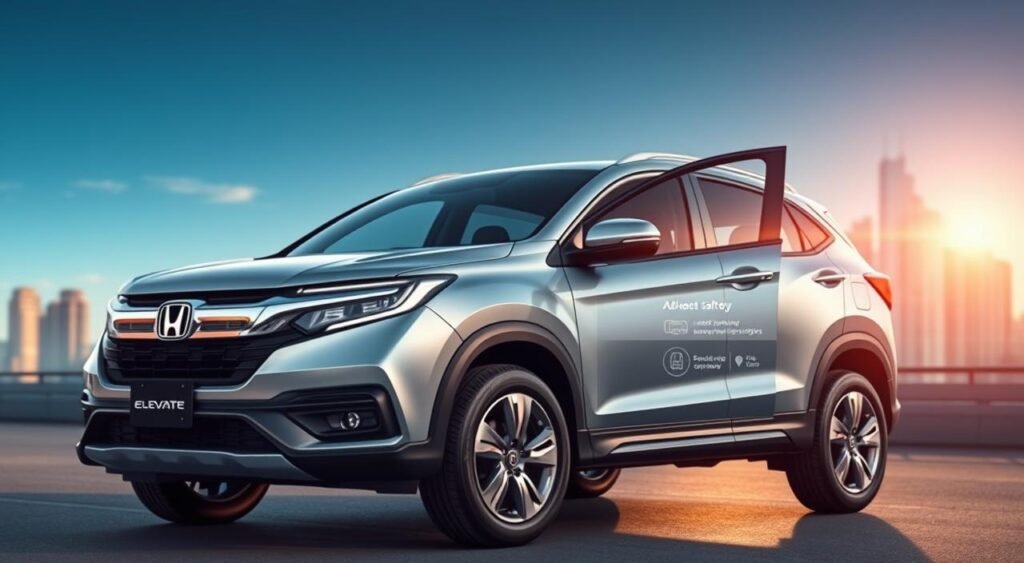
The Lane Keeping Assist System (LKAS) stops you from drifting out of your lane by helping steer. A multi-angle rearview camera gives a 180-degree view with lines for safer backing up. The LaneWatch camera shows blind spots on the screen when you turn right.
Crash Test Ratings and Confidence
JNCAP gave the Honda Elevate a five-star crash test safety rating. This high score means it does well in frontal and side impact tests. It also has six airbags for extra protection in crashes.
| Safety Feature | Function |
|---|---|
| Electronic Stability Control | Prevents skidding and loss of control |
| Hill Start Assist | Prevents rollback on inclines |
| Brake Assist | Maximizes braking force in emergencies |
| Auto-dimming IRVM | Reduces glare from following vehicles |
The Honda Elevate has ABS with EBD for better braking. Parking sensors make it easier to park in small spaces. Even though the safety features are impressive, some, like rear cross-traffic alert, are missing from this model.
Pricing and Value Analysis
The Honda Elevate starts at Rs 11.95 lakh for the base SV MT model. It goes up to Rs 17.07 lakh for the top ZX CVT Dual Tone. Buyers should think if the Elevate fits their budget and needs.
Comparison with Competitors
The Elevate competes in a tough market. Here’s how it compares to main rivals:
| Model | Starting Price | Top Variant Price | Engine Options |
|---|---|---|---|
| Honda Elevate | Rs 11.95 lakh | Rs 17.07 lakh | Petrol only |
| Hyundai Creta | Rs 11.00 lakh | Rs 20.15 lakh | Petrol, Diesel |
| Kia Seltos | Rs 10.90 lakh | Rs 20.35 lakh | Petrol, Diesel |
| Maruti Grand Vitara | Rs 10.99 lakh | Rs 19.93 lakh | Petrol, Hybrid |
The Elevate’s price is in the middle of the pack. It doesn’t offer diesel or hybrid options, which might not appeal to all. But it has good safety and tech features across all models.
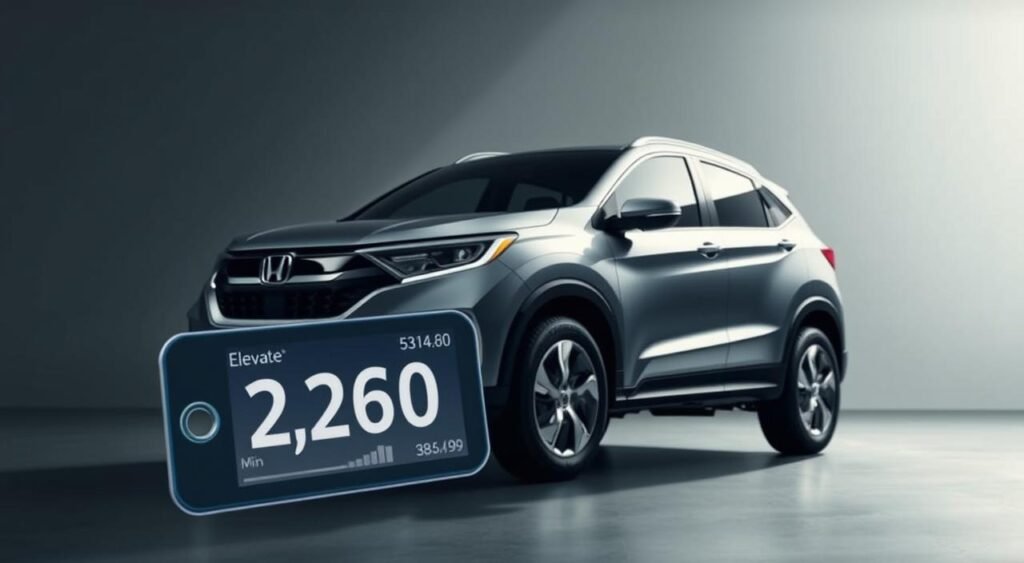
Overall Cost of Ownership
Ownership costs include registration, insurance, and maintenance. The base model costs around Rs 151,806 for registration and Rs 47,648 for insurance. The top model costs Rs 220,687 for registration and Rs 76,698 for insurance.
The Elevate runs on petrol, which is simpler but might cost more to fuel. Honda’s reliability and strong resale value make it a good long-term choice.
Customer Reviews and Market Reception
The updated Honda Elevate has caught the attention of many in India. It has an average rating of 4.6 out of 5 stars from 306 reviews. People love its engine and interior design, making it stand out.
User Experiences and Feedback
Reviews highlight several favorite features. The seats are comfy, and the exterior design handles Indian roads well. Drivers enjoy smooth handling and quick acceleration.
But, there are areas for improvement. Some find the cabin too noisy, and the rear mirrors lack proximity sensors. There are also issues with the ADAS front camera causing sudden braking. Missing features like ventilated seats and a panoramic sunroof are also noted.
Sales Performance
Despite festive offers, the market reception is mixed. Honda’s Great Honda Fest campaign offers big discounts. But, the lack of a diesel engine and competition from Hyundai and Kia are challenges.
Dealers see more traffic during festivals. Yet, Honda needs more engine options to win more customers.
FAQ
What are the key updates in the Honda Elevate?
The Honda Elevate has some big updates. It now has a new Alpha-Bold Plus Grille option. The ZX grade gets a premium Ivory and Black two-tone interior with leatherette seats.
FAQ
What are the key updates in the Honda Elevate?
The Honda Elevate has some big updates. It now has a new Alpha-Bold Plus Grille option. The ZX grade gets a premium Ivory and Black two-tone interior with leatherette seats.
FAQ
What are the key updates in the Honda Elevate?
The Honda Elevate has some big updates. It now has a new Alpha-Bold Plus Grille option. The ZX grade gets a premium Ivory and Black two-tone interior with leatherette seats.
What is the price range for the updated Honda Elevate?
FAQ
What are the key updates in the Honda Elevate?
The Honda Elevate has some big updates. It now has a new Alpha-Bold Plus Grille option. The ZX grade gets a premium Ivory and Black two-tone interior with leatherette seats.
FAQ
What are the key updates in the Honda Elevate?
The Honda Elevate has some big updates. It now has a new Alpha-Bold Plus Grille option. The ZX grade gets a premium Ivory and Black two-tone interior with leatherette seats.
What are the Honda Elevate specs and dimensions?
FAQ
What are the key updates in the Honda Elevate?
The Honda Elevate has some big updates. It now has a new Alpha-Bold Plus Grille option. The ZX grade gets a premium Ivory and Black two-tone interior with leatherette seats.
FAQ
What are the key updates in the Honda Elevate?
The Honda Elevate has some big updates. It now has a new Alpha-Bold Plus Grille option. The ZX grade gets a premium Ivory and Black two-tone interior with leatherette seats.
What engine powers the Honda Elevate and what’s its performance?
FAQ
What are the key updates in the Honda Elevate?
The Honda Elevate has some big updates. It now has a new Alpha-Bold Plus Grille option. The ZX grade gets a premium Ivory and Black two-tone interior with leatherette seats.
FAQ
What are the key updates in the Honda Elevate?
The Honda Elevate has some big updates. It now has a new Alpha-Bold Plus Grille option. The ZX grade gets a premium Ivory and Black two-tone interior with leatherette seats.
What safety features does the Honda Elevate offer?
FAQ
What are the key updates in the Honda Elevate?
The Honda Elevate has some big updates. It now has a new Alpha-Bold Plus Grille option. The ZX grade gets a premium Ivory and Black two-tone interior with leatherette seats.
FAQ
What are the key updates in the Honda Elevate?
The Honda Elevate has some big updates. It now has a new Alpha-Bold Plus Grille option. The ZX grade gets a premium Ivory and Black two-tone interior with leatherette seats.
How does the Honda Elevate compare with competitors?
FAQ
What are the key updates in the Honda Elevate?
The Honda Elevate has some big updates. It now has a new Alpha-Bold Plus Grille option. The ZX grade gets a premium Ivory and Black two-tone interior with leatherette seats.
FAQ
What are the key updates in the Honda Elevate?
The Honda Elevate has some big updates. It now has a new Alpha-Bold Plus Grille option. The ZX grade gets a premium Ivory and Black two-tone interior with leatherette seats.
Is the Honda Elevate worth it based on customer reviews?
FAQ
What are the key updates in the Honda Elevate?
The Honda Elevate has some big updates. It now has a new Alpha-Bold Plus Grille option. The ZX grade gets a premium Ivory and Black two-tone interior with leatherette seats.
FAQ
What are the key updates in the Honda Elevate?
The Honda Elevate has some big updates. It now has a new Alpha-Bold Plus Grille option. The ZX grade gets a premium Ivory and Black two-tone interior with leatherette seats.
What special editions are available for the Honda Elevate?
FAQ
What are the key updates in the Honda Elevate?
The Honda Elevate has some big updates. It now has a new Alpha-Bold Plus Grille option. The ZX grade gets a premium Ivory and Black two-tone interior with leatherette seats.
FAQ
What are the key updates in the Honda Elevate?
The Honda Elevate has some big updates. It now has a new Alpha-Bold Plus Grille option. The ZX grade gets a premium Ivory and Black two-tone interior with leatherette seats.

Oct
Could September 2025 be a game-changer for India’s car market? It’s set to see a flood of new car releases. These changes could alter how people choose their next vehicle.
Six big names are ready to show off their latest models in September 2025. Maruti Suzuki will kick things off with a new SUV on September 3rd. VinFast will introduce two electric cars in India on September 6th. Citroen will unveil the Basalt X on September 5th. Mahindra will update the Thar, and Volvo will launch the EX30 by the end of the month.
These new cars will cost between Rs 9.7 lakh and Rs 50 lakh. This range offers something for everyone, from budget-friendly SUVs to high-end electric vehicles. It shows how India’s car market is growing, with both traditional and electric options available.
Key Takeaways
- Six major car brands schedule launches throughout September 2025
- Price points range from Rs 9.7 lakh to Rs 50 lakh across different segments
- VinFast enters India with two electric models on September 6th
- Maruti Suzuki kicks off the month with a new SUV on September 3rd
- Electric and traditional fuel options provide diverse choices for buyers
- Mahindra Thar receives updates while maintaining its rugged appeal
- Volvo EX30 brings Swedish safety innovation to the electric segment
Overview of September 2025 Car Launches
September 2025 is a big month for the car world. Many new vehicles will be shown off, combining the latest tech with designs that people love. This month, we’ll see more electric cars, affordable luxury, and better safety features.

What to Expect from the Latest Models
This month, there’s something for everyone. Maruti’s new SUV is perfect for those who want something in between the Brezza and Grand Vitara. VinFast is launching two electric SUVs in Tamil Nadu. Citroen is adding a premium touch to the Basalt X with black finishes and ambient lights.
Mahindra is updating the Thar with a modern twist, keeping its rugged charm. Volvo is joining the electric compact car market with the EX30, showing their dedication to green cars.
Exciting Innovations in Design and Technology
September will bring big tech leaps in cars. Some highlights include:
- Panoramic sunroofs becoming standard in mid-segment vehicles
- Level-2 ADAS (Advanced Driver Assistance Systems) for enhanced safety
- 360-degree camera systems for improved visibility
- Larger touchscreen displays reaching up to 12.9 inches
- Wireless charging capabilities and ventilated seats
- Advanced battery technologies for up to 496 kilometers range
These new cars show how manufacturers are listening to what people want. They’re making tech-rich, eco-friendly cars that are also affordable.
Spotlight on Maruti Escudo
The Maruti Escudo is one of the most awaited cars in September 2025. It’s a big step for Maruti to enter the mid-size SUV market. Built on Suzuki’s Global C platform, it offers great value and reliability.
Key Features of the Maruti Escudo
The Maruti Escudo has features that match high-end cars. It has a long wheelbase for more space, perfect for Indian families. All models come with:
- Panoramic sunroof for an airy feel
- Ventilated front seats for comfort in hot weather
- Six airbags for safety
- 360-degree camera system for easy parking
- Advanced Driver Assistance Systems (ADAS) in higher variants
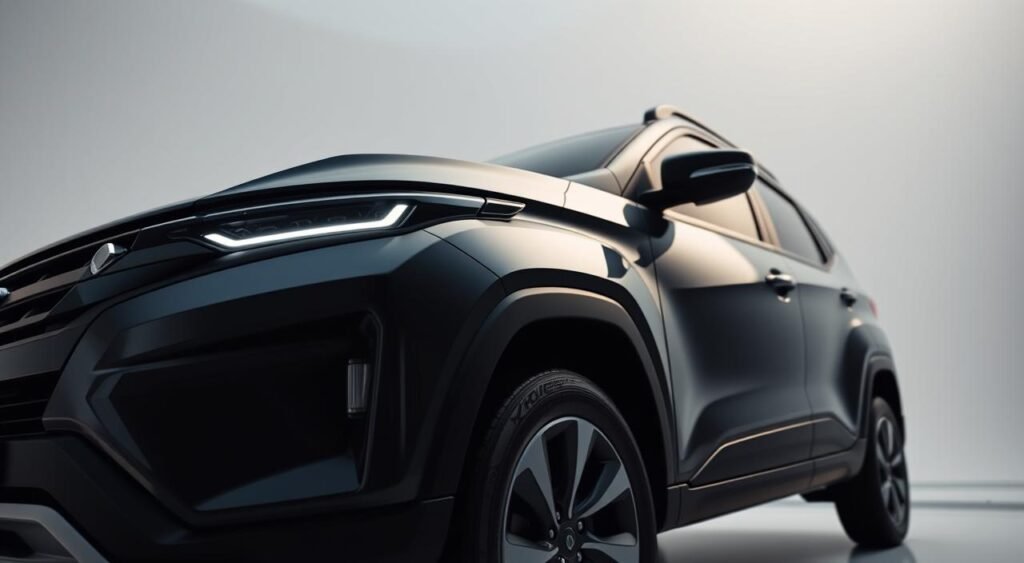
It has three engine options. The 1.5-liter petrol engine has mild-hybrid tech for better fuel use. There’s also a strong hybrid and a CNG option for those who want to save money.
Pricing and Availability Timelines
The Maruti Escudo launches on September 3, 2025, starting at Rs 9.7 lakh (ex-showroom). It’s priced well between the Brezza and Grand Vitara. It will be sold through Arena dealerships across India.
Bookings start in late August 2025. Deliveries will begin right after the launch. Thanks to Maruti’s production and dealer network, there won’t be long waits.
Spotlight on Volvo EX30
The Volvo EX30 is a standout in September 2025 car launches. It’s Volvo’s most compact electric vehicle. This car brings premium electric mobility to a new market.
It’s expected to hit dealerships by late September. The price is around Rs 50 lakh. The EX30 is a gateway to Volvo’s electric future.
Unique Selling Propositions of the EX30
The Volvo EX30 showcases Scandinavian design in the compact electric segment. Its exterior features Thor hammer-shaped LED daytime running lights. This makes it instantly recognizable.
The car has 19-inch aerodynamic alloy wheels. These wheels boost efficiency and look great. L-shaped LED tail lights add to its modern look.
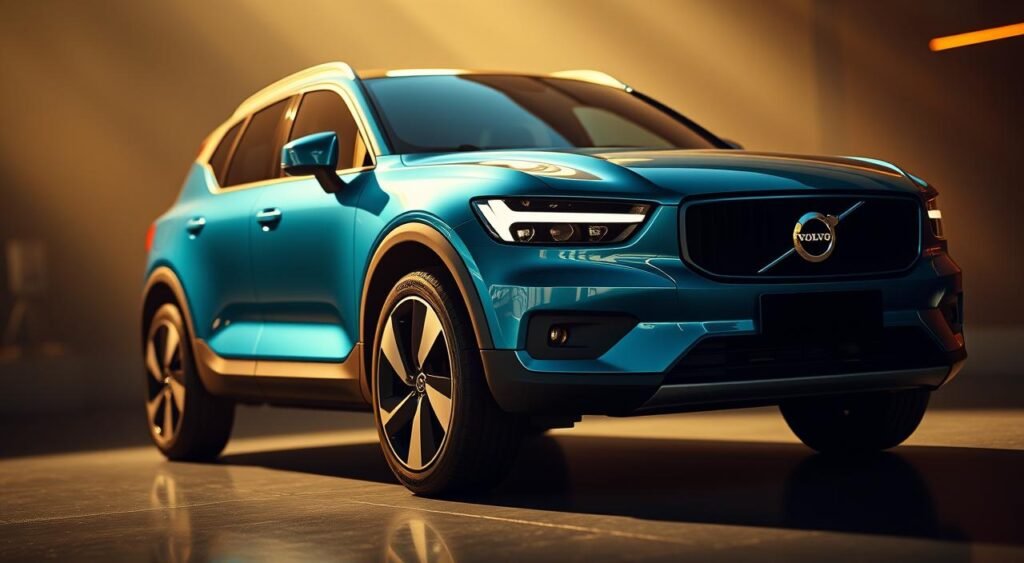
Inside, the EX30 is all about minimalism. It has a 12.3-inch central touchscreen for controlling most functions. It also has:
- Fixed panoramic glass roof for an airy feel
- Dual-zone climate control for comfort
- Wireless charging for devices
- Single 69 kWh battery pack
- Rear-wheel drive system with 272 PS motor
- WLTP-certified range of 480 kilometers
Safety Innovations in Volvo Vehicles
Volvo is known for its safety, and the EX30 is no exception. It comes with seven airbags for protection. A 360-degree camera system offers full visibility.
Advanced Driver Assistance Systems (ADAS) help prevent collisions. These features show Volvo’s dedication to safety in electric vehicles.
Other Notable Car Launches
September 2025 is packed with exciting new car releases in India. These models offer different prices and features for various buyers. From electric to traditional cars, the latest trends and preferences are on display.
Overview of Additional Brands and Models
VinFast brings two electric SUVs to India on September 6. The VF6 starts at Rs 25 lakh with a 59.6 kWh battery for 410 km range. It comes in two variants and six colors, aiming at the premium electric market.
The VF7 launches at Rs 50 lakh with a 70.8 kWh battery for 496 km range. It has eight airbags and a 12.9-inch touchscreen in three variants.
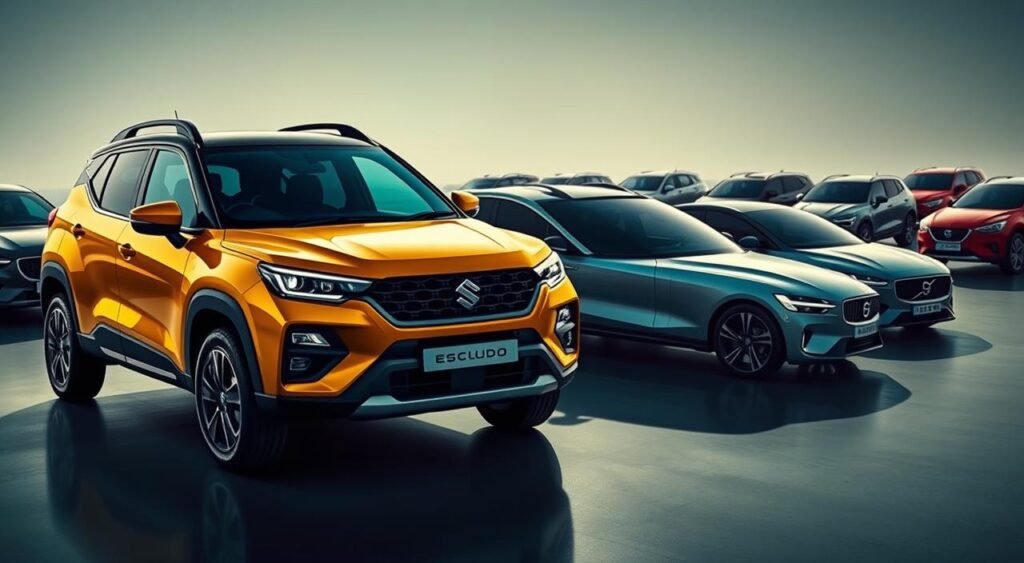
Citroen introduces the Basalt X on September 5 at Rs 14.13 lakh. It has a black finish, ambient lighting, and a 10.2-inch touchscreen. It offers two engine options.
The Mahindra Thar facelift arrives late September at Rs 12 lakh. It features circular LED headlights and a 10.25-inch touchscreen with a digital driver display.
Market Impact and Anticipated Trends
These new releases mark significant changes in India’s car market. VinFast’s electric vehicles add to the EV competition. Citroen and Mahindra focus on upgrading popular models.
The prices range from Rs 12 lakh to Rs 50 lakh. This shows manufacturers are aiming at various segments.
| Model | Starting Price | Key Feature | Launch Date |
|---|---|---|---|
| VinFast VF6 | Rs 25 lakh | 410 km electric range | September 6 |
| VinFast VF7 | Rs 50 lakh | 496 km electric range | September 6 |
| Citroen Basalt X | Rs 14.13 lakh | Black edition styling | September 5 |
| Mahindra Thar | Rs 12 lakh | LED headlights upgrade | Late September |
These updates show a focus on both electric and traditional cars. The variety in options ensures there’s something for everyone in September 2025.
Industry Reactions and Expert Reviews
The car world is buzzing with the 2025 lineup. VinFast is making waves in India with the VF6 and VF7. Their move to Tamil Nadu shows they’re serious about making cars locally.
Initial Impressions from Automotive Experts
Top car critics are talking about Maruti’s new SUV. It fills a gap between the Brezza and Grand Vitara. The Mahindra Thar facelift is also getting attention, coming four years after its debut.
Volvo EX30 is seen as a great deal in the Rs 40-42 lakh range. It makes electric luxury cars more affordable for Indians.
Consumer Anticipations and Feedback
People are excited about the new cars. Citroen’s Basalt X bookings started at Rs 11,000, showing strong interest. Social media is full of:
- VinFast’s EV prices
- Mahindra Thar’s updates
- Maruti’s SUV options
- Volvo EX30’s value
| Brand | Model | Consumer Interest Level | Key Attraction |
|---|---|---|---|
| VinFast | VF6/VF7 | High | New EV technology |
| Maruti | New SUV | Very High | Segment positioning |
| Mahindra | Thar Facelift | High | Design refresh |
| Volvo | EX30 | Moderate | Premium EV value |
Environmental Considerations in New Models
The car industry is getting greener, thanks to new car news in September 2025. Companies are making cleaner cars to fight climate change. This month, they show they care about the planet with new, eco-friendly ways.
How Brands Address Sustainability in 2025
Big car makers are going green in their own ways. VinFast is a leader with its factory in Tamil Nadu. It cuts down on carbon by making cars closer to where they’re sold.
Maruti is also making a big push with the Escudo. It offers:
- Mild-hybrid tech for better gas use
- Strong hybrid to cut emissions by up to 40%
- CNG option for cleaner burning

Electric and Hybrid Options Available
New cars are getting a big boost from electric power. Three electric cars lead the charge in September:
| Model | Range (km) | Charging Time |
|---|---|---|
| VinFast VF6 | 410 | 27 minutes (10-70%) |
| Volvo EX30 | 480 | 26 minutes (10-80%) |
| VinFast VF7 | 496 | 31 minutes (10-70%) |
These cars can go far on a single charge. They charge up fast, so you don’t wait long. There are also hybrid and CNG options for those who want to help the planet but aren’t ready for electric.
Conclusion and Future Expectations
The September 2025 car launches are a big deal for the Indian car market. Prices range from Rs 9.7 lakh for the Maruti Escudo to Rs 50 lakh for premium cars. This shows makers are trying to meet every customer’s needs during the festive season.
The Future of the Auto Industry Beyond September 2025
VinFast is coming to India, bringing electric cars to the market. Their prices might make more people choose electric cars in big cities. Mahindra and Maruti are also changing their SUVs to fit what people want now.
This change shows the car world is moving towards green cars but keeping prices low. Volvo and others are making electric cars more affordable. This means customers have more choices, even as rules get stricter on pollution.
Final Thoughts on This Month’s Exciting Launches
September 2025 car launches show the Indian car world is ready to change and grow. Each car meets different needs, from city driving to off-road adventures. These new cars will raise the bar for quality, tech, and value in the future.
FAQ
What are the major car debuts expected in September 2025?
September 2025 will see six big car launches. Maruti Suzuki’s new SUV hits the market on September 3. VinFast VF6 and VF7 electric models debut on September 6. Citroen Basalt X is set for September 5. The Mahindra Thar facelift and Volvo EX30 are expected by the end of the month.
What is the price range for the new car releases in September 2025?
The new cars will range from Rs 9.7 lakh to Rs 50 lakh. This covers a wide range of budgets, making something for everyone.
Which electric vehicles are launching in September 2025?
Three electric cars are launching. VinFast VF6 and VF7 offer ranges of 410 km and 496 km. The Volvo EX30 boasts a 480 km WLTP-claimed range, pushing for green mobility.
What are the key features of the Maruti Escudo?
The Maruti Escudo has a panoramic sunroof and ventilated front seats. It also comes with six airbags, a 360-degree camera, and possibly ADAS. It offers mild-hybrid, strong hybrid, and CNG options.
When can customers book the latest car models launching in September?
Citroen Basalt X bookings are open at Rs 11,000. Other brands will announce booking dates closer to their launch in September.
What safety features are included in the Volvo EX30?
The Volvo EX30 has seven airbags and a 360-degree camera system. It also includes Advanced Driver Assistance Systems (ADAS), ensuring top safety.
Which car news September 2025 relates to local manufacturing?
VinFast’s VF6 and VF7 will be made in Tamil Nadu. This shows VinFast’s commitment to local production in India, cutting down on carbon footprint.
What are the expected automotive industry updates regarding the Mahindra Thar?
The updated Mahindra Thar is expected by end-September at Rs 12 lakh. It features Roxx-inspired design and tech like circular LED headlights and a 10.25-inch touchscreen. It keeps its petrol-diesel engines and offers RWD and 4WD options.
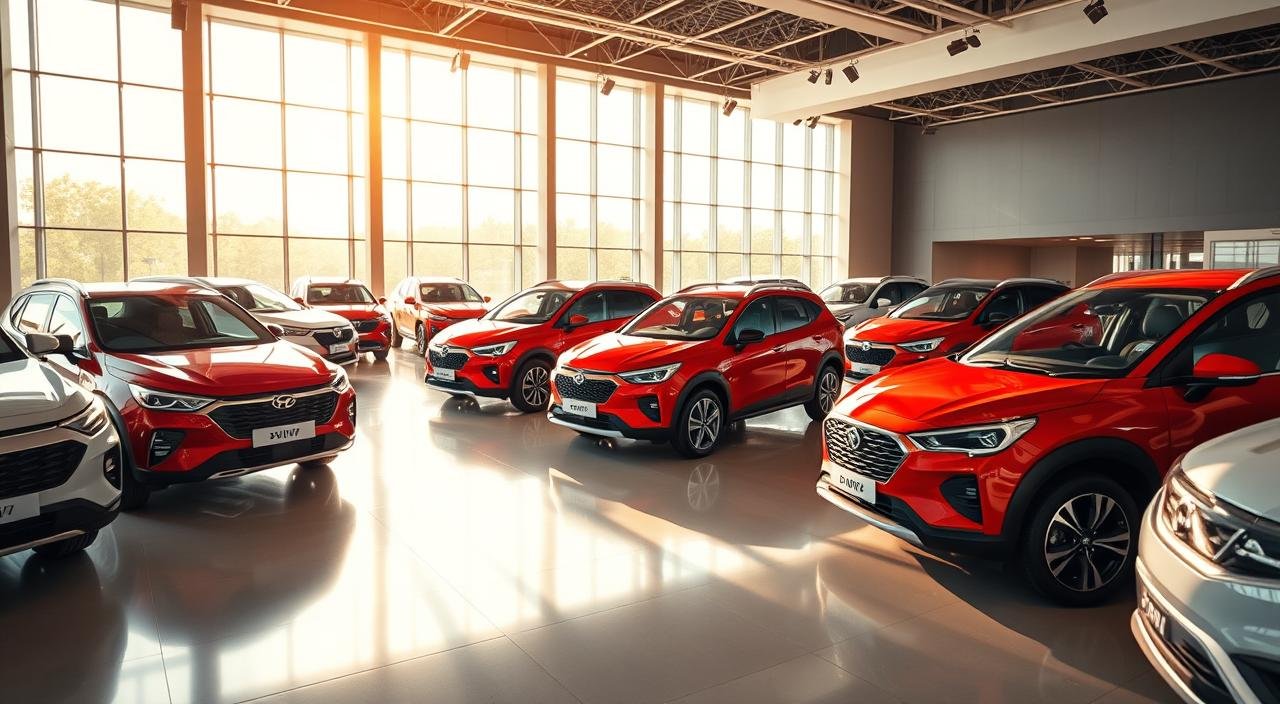
Oct
Did August 2025 see the most diverse month for car launches in India? The month saw cars priced from Rs 5.76 lakh to Rs 1.35 crore. This change marked a big shift in the automotive world.
August 2025 brought a wide range of new cars to India. Brands like Mercedes-AMG and Renault made big updates. SUVs were the most popular, making up 65% of all new cars.
New cars in India 2025 show what buyers want. Electric and hybrid cars made up 10% of the launches. The Renault Kiger Facelift was launched at Rs 6.29 lakh, and the Mercedes-AMG CLE 53 Coupe was priced at Rs 1.35 crore.
The latest cars in India came with new tech and safety features. The Renault Kiger got LED projector headlamps and a unique 10-slat grille. Mercedes-AMG’s CLE 53 Coupe had a 3-litre engine, making 450 PS and going from 0 to 100 kmph in 4.2 seconds.
Key Takeaways
- August 2025 saw a wide range of car launches from Rs 5.76 lakh to Rs 1.35 crore
- SUVs were the most popular, making up 65% of all new cars
- Electric and hybrid vehicles made up 10% of all launches
- Renault Kiger Facelift started at Rs 6.29 lakh with new features
- Mercedes-AMG CLE 53 Coupe was the top luxury car at Rs 1.35 crore
- Performance models had engines making up to 450 PS power
- There were cars for all budgets, from entry-level to premium
Overview of the Automotive Market in India in August 2025
The Indian car market saw big changes in August 2025. New models were released that show what people want to buy. These *top car releases August 2025* had special editions and new looks for different prices.

Black-themed cars were very popular in the *upcoming vehicles India 2025* lineup. Nissan brought out the Magnite Kuro Edition for Rs 7.6-9.94 lakh. It had cool black styling.
Maruti Suzuki also had the Grand Vitara Phantom Blaq Edition in matte black. The Mahindra BE 6 Batman Edition was a special edition, limited to 999 units at Rs 27.79 lakh. It showed the trend of dark colors.
Recent Trends Influencing Car Launches
Anniversary editions were another big thing in *car industry news* this month. Brands celebrated big years with special models. These models were unique and attracted collectors and fans.
Car makers focused on looks over performance. This way, they could offer new cars without spending a lot on changes.
Key Manufacturers and Their Strategies
Big car makers had different plans to win more customers. Renault updated their cars with new looks but kept prices low. Mercedes-AMG went for high-end models.
Citroën added the C3X to their affordable range starting at Rs 7.91 lakh. Toyota let dealers customize the Camry Sprint Edition at Rs 47.48 lakh. BMW introduced special editions of the 330Li and M340i, each limited to 50 units.
Major Launches of August 2025
August 2025 was a big month for automobile releases India in many areas. The car world showed off new electric cars, fancy SUVs, and useful small cars. This in-depth car launch coverage talks about the top models that caught people’s eyes.
Spotlight on Electric Vehicles
The electric car world shone bright with Mahindra’s BE 6 Batman Edition leading the way. It has a big 79kWh battery and a strong 286 PS electric motor. It can go 683 km on one charge, making it a top pick for 2025.
This special edition has two 12.9-inch screens and a top-notch 16-speaker Harman Kardon sound system. It also has advanced safety features for everyone inside.
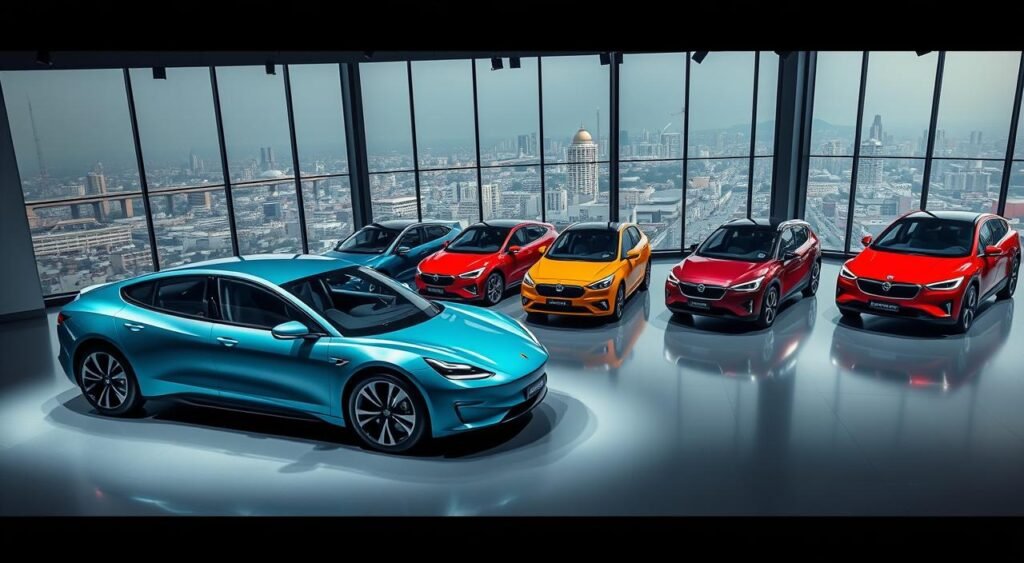
Notable Launches in the SUV Segment
SUVs were big in automobile releases India this month. The Citroën C3X came with cool LED lights and a big 10.25-inch screen. It’s priced well from Rs 7.91 lakh and has automatic climate control.
Maruti Suzuki marked Nexa’s 10th year with the Grand Vitara Phantom Blaq edition. This special model has:
- Black-themed interiors with champagne-gold accents
- Premium leatherette upholstery
- A 1.5-litre three-cylinder strong-hybrid engine producing 116 PS
Compact Cars Making Waves
The small car world saw exciting updates in best new cars 2025. Renault’s Kiger Facelift has two engine choices – a 72 PS 1-litre and a 100 PS turbo-petrol. It comes with manual, AMT, and CVT transmissions, and costs up to Rs 11.29 lakh.
Nissan brought the Magnite Kuro Edition for those who love style. It has a black grille, 16-inch wheels, and piano-black inside. But it keeps the same specs as the regular models.
Featured Models from Popular Brands
The latest car models in India show off innovation from top makers. August 2025 brings new updates from brands like Toyota, Honda, and Hyundai. Each has unique features and prices that stand out.
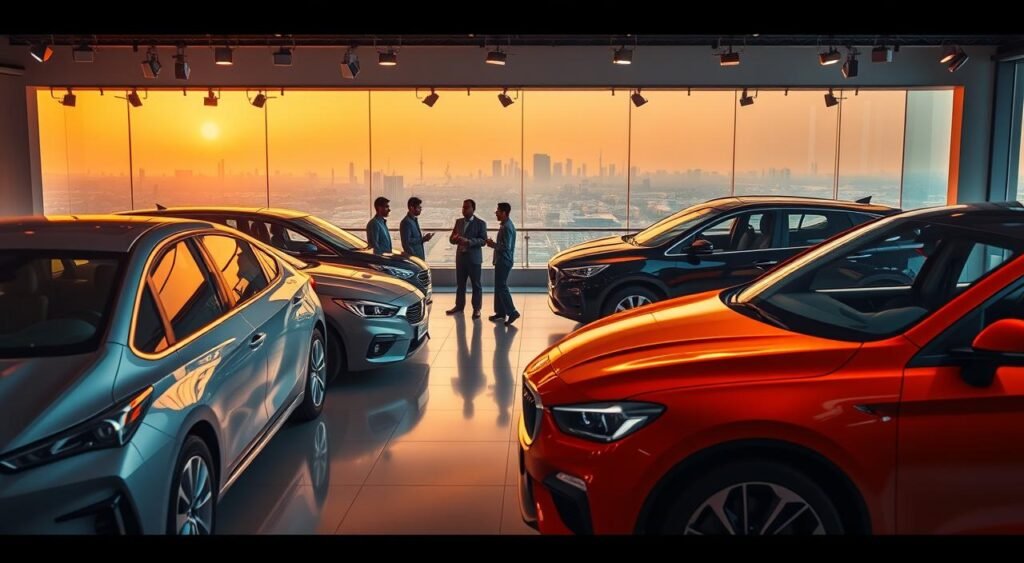
Toyota’s Latest Offerings
Toyota introduces the Camry Sprint Edition for Rs 48.50 lakh. It has a matte black hood and roof and blackout alloys. The interior shines with ambient lighting and door warning lights.
Key features include:
- Triple-zone climate control for enhanced comfort
- Premium JBL speaker system
- 12.3-inch digital driver’s display
- 230 PS 2.5-litre strong-hybrid powertrain
Honda’s Innovative Designs
Honda was a bit quiet in August 2025, but they’re working on new models. They’re making cars just for Indian buyers, with big plans for the future.
New Entries from Hyundai
Hyundai celebrates the Creta’s 10-year mark with three special editions. The King, King Knight, and King Limited cost from Rs 17.27 to 20.20 lakh. They come with different engine options.
The second-generation Venue is coming on August 24. It will have:
- Redesigned grille with rectangular inserts
- Split headlamp arrangement with full-width LED light bar
- Refreshed dashboard with larger touchscreen
- Digital instrument cluster and panoramic sunroof
- Dual-zone climate control
Performance and Features Highlight
The top car releases in August 2025 bring new tech and better performance. Indian and global brands have raised the bar. They offer faster, safer, and more efficient cars. These changes meet the needs of today’s car buyers who want quality at good prices.
Advanced Technology Introduced
The Mercedes-AMG CLE 53 has a top-notch sound system and memory seats. It also has advanced safety features that let it go up to 270 kmph. The Citroën C3X adds wireless tech for music and maps, along with a cool digital display and charging ports.

Safety Features to Note
Car news shows more safety features in all price ranges. The Mahindra BE 6 has smart cruise control and lots of airbags. It even has Batman-themed customization without losing safety. These features are now common in new cars coming to India in 2025.
Fuel Efficiency Improvements
Hybrid cars are getting better at saving fuel. The Toyota Camry Sprint uses a special gearbox for better hybrid power. The Maruti Grand Vitara Phantom Blaq gets better gas mileage with its hybrid engine. The BMW X5 M Sport Pro and Renault Kiger also offer good fuel economy.
Pricing and Availability Information
The August 2025 car releases in India showed a wide range of prices. The cheapest cars started at Rs 5.76 lakh, while the most expensive reached Rs 1.35 crore. Every category had something for everyone, with different prices in different places.
Price Ranges for New Models
Renault Kiger’s starting price of Rs 5.76 lakh was a hit with budget shoppers. The compact SUV market was fierce, with prices like Citroën C3X from Rs 7.91-10.15 lakh and Nissan Magnite Kuro Edition from Rs 7.6-9.94 lakh. These cars are perfect for first-time buyers looking for a good deal.
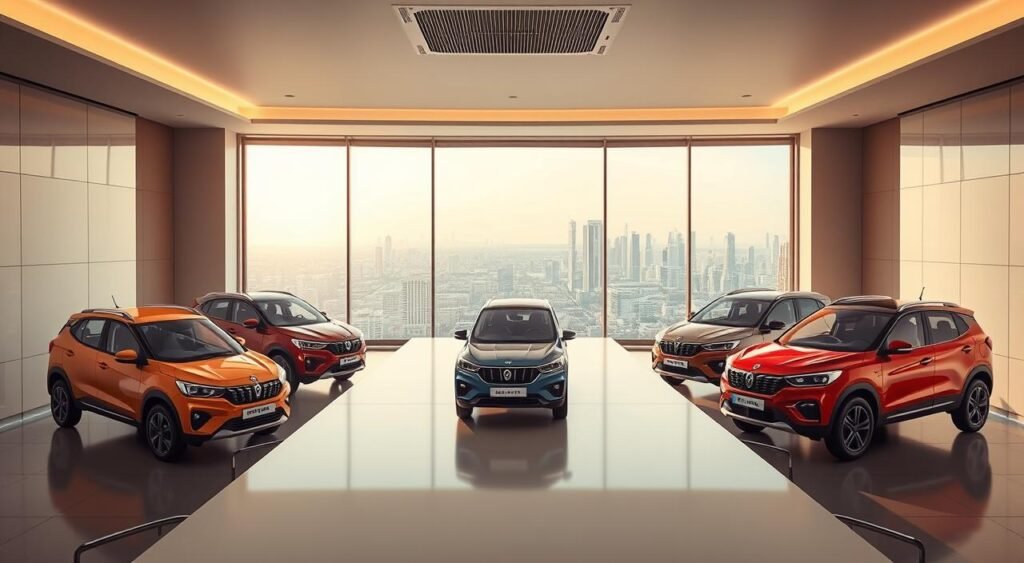
For those looking for something more, Hyundai Creta special editions were priced at Rs 17.27-20.20 lakh. Luxury seekers could consider the BMW 330Li at Rs 64 lakh or the exclusive M340i 50 Jahre Edition at Rs 76.90 lakh. The top of the line was the BMW X5 M Sport Pro petrol at Rs 1.13 crore and diesel at Rs 1.15 crore. Mercedes-AMG CLE 53 was the priciest at Rs 1.35 crore.
Expected Availability Dates
Renault Kiger facelift hit the market on August 24. Mahindra BE 6 Batman Edition will start deliveries on September 20, International Batman Day. Limited production made these cars hot items. BMW’s anniversary editions were made in just 50 units each. Skoda’s 25th anniversary models were capped at 500 units. The Mahindra BE 6 Batman Edition’s 999 units sold out fast.
Regional Variations in Pricing
Prices varied by state due to local taxes and fees. Customization packages at dealerships added to the cost. For example, the Maruti Grand Vitara Phantom Blaq package cost Rs 1.05 lakh extra. Big cities paid 3-5% more than smaller cities.
| Model | Base Price (Rs) | Top Variant (Rs) | Availability |
|---|---|---|---|
| Renault Kiger | 5.76 lakh | 8.99 lakh | August 24 |
| Citroën C3X | 7.91 lakh | 10.15 lakh | Immediate |
| Nissan Magnite Kuro | 7.6 lakh | 9.94 lakh | Immediate |
| Hyundai Creta SE | 17.27 lakh | 20.20 lakh | Immediate |
| BMW 330Li | 64 lakh | 64 lakh | Limited Stock |
Conclusion and Future Outlook for Car Launches
The car world in India is changing fast. Car makers are using new tech and listening to what people want. The latest cars in August 2025 show a big move towards electric cars and cool features. Brands are bringing out new models in all kinds of categories.
Emerging Trends to Watch For
Electric cars are leading the way with the Maruti Suzuki e Vitara coming soon. It has big batteries for long drives and lots of power. It’s set to take on MG Windsor and Hyundai Creta Electric.
There are also special editions and anniversary models. These show how car makers use uniqueness and history to sell cars.
Anticipated Launches in the Coming Months
September will see more new cars in India, just in time for the festivals. Tata is bringing back the Sierra with electric and gas options. It has a unique design and lots of screens inside.
VinFast is also coming to India with electric SUVs. Maruti Suzuki has a new car, the Escudo, ready for September 3, 2025. It will have different kinds of engines to compete with other SUVs.
FAQ
What were the most significant new car launches in India during August 2025?
August 2025 saw exciting new cars hit the market. The Renault Kiger Facelift started at Rs 6.29 lakh. Mercedes-AMG CLE 53 Coupe was priced at Rs 1.35 crore.
FAQ
What were the most significant new car launches in India during August 2025?
August 2025 saw exciting new cars hit the market. The Renault Kiger Facelift started at Rs 6.29 lakh. Mercedes-AMG CLE 53 Coupe was priced at Rs 1.35 crore.
Which electric vehicles were launched in August 2025?
FAQ
What were the most significant new car launches in India during August 2025?
August 2025 saw exciting new cars hit the market. The Renault Kiger Facelift started at Rs 6.29 lakh. Mercedes-AMG CLE 53 Coupe was priced at Rs 1.35 crore.
FAQ
What were the most significant new car launches in India during August 2025?
August 2025 saw exciting new cars hit the market. The Renault Kiger Facelift started at Rs 6.29 lakh. Mercedes-AMG CLE 53 Coupe was priced at Rs 1.35 crore.
What are the price ranges for the latest car models in India?
FAQ
What were the most significant new car launches in India during August 2025?
August 2025 saw exciting new cars hit the market. The Renault Kiger Facelift started at Rs 6.29 lakh. Mercedes-AMG CLE 53 Coupe was priced at Rs 1.35 crore.
FAQ
What were the most significant new car launches in India during August 2025?
August 2025 saw exciting new cars hit the market. The Renault Kiger Facelift started at Rs 6.29 lakh. Mercedes-AMG CLE 53 Coupe was priced at Rs 1.35 crore.
Which brands focused on anniversary or special editions in August 2025?
FAQ
What were the most significant new car launches in India during August 2025?
August 2025 saw exciting new cars hit the market. The Renault Kiger Facelift started at Rs 6.29 lakh. Mercedes-AMG CLE 53 Coupe was priced at Rs 1.35 crore.
FAQ
What were the most significant new car launches in India during August 2025?
August 2025 saw exciting new cars hit the market. The Renault Kiger Facelift started at Rs 6.29 lakh. Mercedes-AMG CLE 53 Coupe was priced at Rs 1.35 crore.
What transmission options are available in the new Renault Kiger Facelift?
FAQ
What were the most significant new car launches in India during August 2025?
August 2025 saw exciting new cars hit the market. The Renault Kiger Facelift started at Rs 6.29 lakh. Mercedes-AMG CLE 53 Coupe was priced at Rs 1.35 crore.
FAQ
What were the most significant new car launches in India during August 2025?
August 2025 saw exciting new cars hit the market. The Renault Kiger Facelift started at Rs 6.29 lakh. Mercedes-AMG CLE 53 Coupe was priced at Rs 1.35 crore.
Are there any upcoming vehicles India 2025 buyers should anticipate?
FAQ
What were the most significant new car launches in India during August 2025?
August 2025 saw exciting new cars hit the market. The Renault Kiger Facelift started at Rs 6.29 lakh. Mercedes-AMG CLE 53 Coupe was priced at Rs 1.35 crore.
FAQ
What were the most significant new car launches in India during August 2025?
August 2025 saw exciting new cars hit the market. The Renault Kiger Facelift started at Rs 6.29 lakh. Mercedes-AMG CLE 53 Coupe was priced at Rs 1.35 crore.
What advanced features do the top car releases August 2025 offer?
FAQ
What were the most significant new car launches in India during August 2025?
August 2025 saw exciting new cars hit the market. The Renault Kiger Facelift started at Rs 6.29 lakh. Mercedes-AMG CLE 53 Coupe was priced at Rs 1.35 crore.
FAQ
What were the most significant new car launches in India during August 2025?
August 2025 saw exciting new cars hit the market. The Renault Kiger Facelift started at Rs 6.29 lakh. Mercedes-AMG CLE 53 Coupe was priced at Rs 1.35 crore.
How did the automobile releases India market perform in terms of segment distribution?
FAQ
What were the most significant new car launches in India during August 2025?
August 2025 saw exciting new cars hit the market. The Renault Kiger Facelift started at Rs 6.29 lakh. Mercedes-AMG CLE 53 Coupe was priced at Rs 1.35 crore.
Oct
Kia Corporation has mixed the practicality of an MPV with the style of an SUV. This has led to two new models that will change India’s car scene.
The Kia Carens Clavis Revealed is a big step in India’s car market. It starts at Rs. 11.50 Lakh and comes in 24 variants. It has both petrol and diesel engines and various transmission options.
Kia has also introduced the Carens Clavis EV, India’s first electric car from Kia. It has two battery sizes and can go up to 490 kilometers on a single charge.
Both models are made at Kia’s top-notch factory in India. They show Kia’s dedication to making cars for everyone. The Carens combines SUV looks with MPV practicality, perfect for Indian families.
Key Takeaways
- Kia Carens Clavis MPV starts at Rs. 11.50 Lakh with 24 variants available
- First made-in-India electric vehicle from Kia with up to 490 km range
- Multiple transmission options including manual, automatic DCT, and clutchless manual
- Both petrol and diesel engine options for diverse customer preferences
- Manufactured at Kia’s Indian facility showing local production skills
- SUV-inspired design merged with MPV practicality for lifestyle-oriented buyers
Overview of the Kia Carens Clavis
The Kia Carens Clavis is a big step forward in the MPV world. It brings new tech and design to family cars. This car is all about making driving better with its mix of useful features and luxury.

What Makes the Carens Clavis Stand Out?
The Kia Carens Clavis has a cool feature: two 12.3-inch screens for info and gauges. This setup makes driving feel like a premium experience. You can also get a big sunroof to let in lots of light.
New beige and navy blue upholstery adds a fancy feel to the inside. It’s perfect for those who want style and comfort.
Key Specifications and Features
The Kia Carens has great size and power options for all kinds of drivers:
| Dimension | Measurement |
|---|---|
| Length | 4,550 mm |
| Width | 1,800 mm |
| Height | 1,708-1,730 mm |
| Wheelbase | 2,780 mm |
| Seating Options | 6 or 7 seats |
There are different engines to choose from:
- 1.5L naturally aspirated petrol: 113 bhp with 144 Nm torque
- 1.5L turbo-petrol: 158 bhp with 253 Nm torque
- 1.5L diesel: 114 bhp with 250 Nm torque
- Electric variants: 99kW/225Nm or 126kW/255Nm options
This review shows off the car’s cool features. You get wireless charging, lots of USB ports, and a 360-degree camera. The steering wheel is sporty but also comfy for long drives.
Bold Exterior Design Elements
The Kia Carens has a bold design that makes it stand out. It’s made to catch the eye on Indian roads. It combines sporty looks with smart details for families who want both style and function.
Sleek Lines and Contemporary Style
The Kia Carens has connected DRLs and unique lamps that grab attention. A silver skid plate adds a touch of luxury and protects the bumper. New bumpers and black cladding give it a sleek look.
The air dam adds beauty and boosts aerodynamics. Its LED headlamps and rear light bar create a unified look.
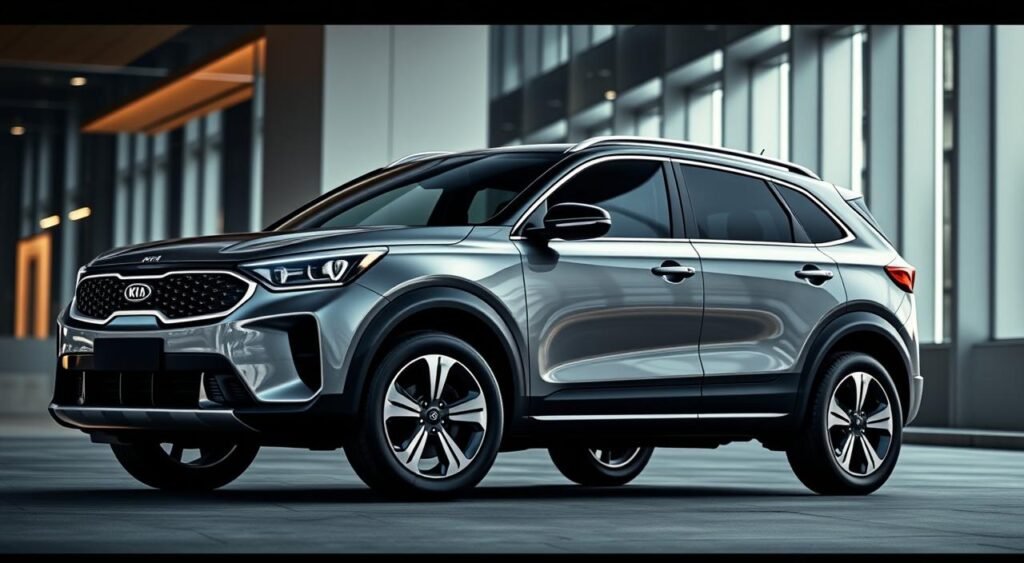
Innovative Lighting Solutions
The Kia Carens lights are a step ahead in tech. Its LED tail lights are modern and bright. They make the car easy to spot at night.
The EV model has special lights that show it’s electric. Yet, it keeps the bold design.
Color Options and Customization
There are six colors to choose from for the Kia Carens:
| Color Option | Finish Type | Best Suited For |
|---|---|---|
| Clear White | Solid | Classic elegance |
| Glacier White Pearl | Pearl | Premium appeal |
| Aurora Black | Pearl | Sporty character |
| Gravity Gray | Metallic | Urban sophistication |
| Imperial Blue | Metallic | Dynamic presence |
| Sparkling Silver | Metallic | Timeless style |
The side has new 17-inch alloy wheels and silver roof rails. The EV model has a special grille and charging port. It also has aero-dynamic wheels that boost efficiency without losing its bold design look.
Luxurious Interior Features
The Kia Carens Clavis raises the bar for luxury interiors in its class. Inside, you’ll find a cabin that rivals top sedans with its elegant design and fine details. Every part shows off careful craftsmanship, making both daily drives and long trips a pleasure.
Premium Materials and Comfort
The Carens stands out with its high-quality materials. It has ventilated front seats for cool comfort in warm weather. The driver’s seat adjusts with manual controls for height, recline, and slide.
New beige and navy blue upholstery options let buyers choose their style. This adds a personal touch to the interior.
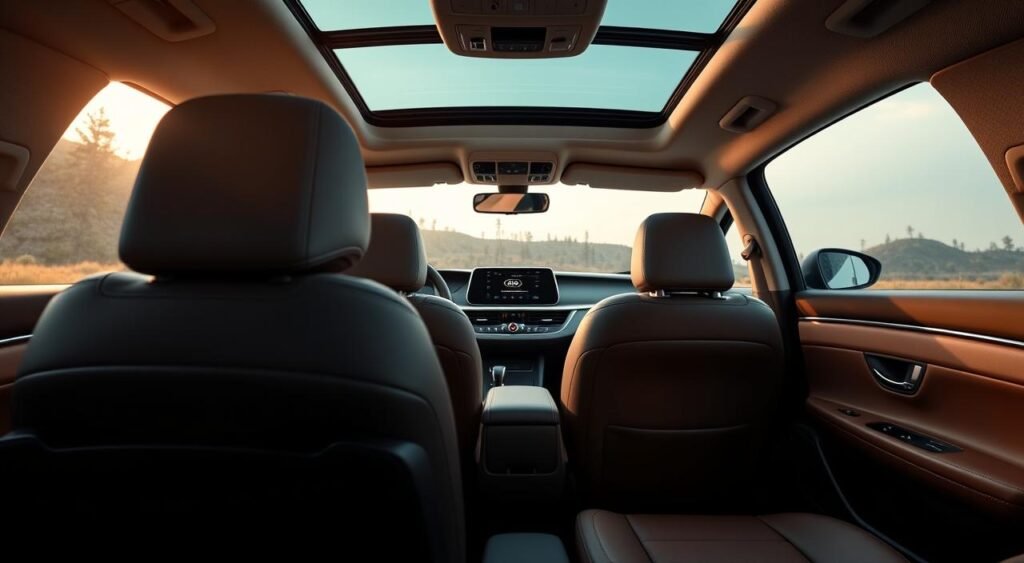
Advanced Technology Integration
Technology is at the forefront with the 26.62-inch Dual Panoramic Display. This huge screen controls all vehicle functions. The 8-speaker Bose audio system brings concert-quality sound to the cabin.
A Smart Pure Air Purifier keeps air clean, and 64-color ambient lighting sets the mood. These features make every drive special.
Space and Versatility for Families
The Kia Carens is perfect for families with its flexible seating. The third row folds and reclines for comfort. Second-row seats tumble with Boss Mode for extra legroom.
Independent slide and recline of middle row seats add to the convenience. Rear sunshades and folding tables make trips easier. The dual-pane sunroof brings in natural light, and the center console has ambient lighting.
With 216 liters of boot space, the Carens handles daily cargo needs well.
Performance and Efficiency
The Kia Carens Clavis offers great performance with its different engines. Each engine balances power and fuel use well. This makes the Kia Carens good for city driving and long trips.
Engine Options and Capabilities
The Kia Carens has three engine types. The base engine is a 1.5-liter petrol that makes 113 horsepower and 144 Nm of torque. For more power, there’s a 1.5-liter turbo-petrol engine that makes 158 horsepower and 253 Nm of torque. It goes from 0-100 km/h in 8.4 to 9.5 seconds.
The diesel engine is a 1.5-liter unit that makes 114 horsepower and 250 Nm of torque. You can choose from several transmissions, including manual, automatic, iMT, and DCT. The electric version has the same acceleration as the turbo-petrol and reaches 166 km/h.

Fuel Economy Ratings
The Kia Carens is also fuel-efficient, which is important for its price. The turbo-petrol engines get between 15.95 and 16.66 kmpl. Diesel engines do even better, getting 17.5 to 19.54 kmpl. This makes the Kia Carens a smart choice for everyday driving.
Driving Experience and Handling
The electric version has i-Pedal 2.0 technology with four regenerative braking levels. You can control these levels with paddle shifters. Auto Mode adjusts regeneration based on traffic.
The liquid-cooled battery pack and Active Air Flap system keep the car at the right temperature. This ensures the car performs well in all driving conditions.
Technology and Safety Innovations
The Kia Carens Clavis introduces cutting-edge tech that sets new standards. It combines smart connectivity with safety systems for peace of mind. The model offers premium features, making it a rival to luxury vehicles while staying practical.
Infotainment System Highlights
The Carens Clavis has over 90 connected car features. It connects to more than 11,000 charging points across India for the EV variant. Digital Key 2.0 lets you unlock your car with your phone, and voice commands control functions without hands off the wheel.
Regular updates keep the system fresh with new features. The AI-powered digital manual answers vehicle questions instantly. Live video consultations connect owners with Kia experts when needed. Pre-emptive maintenance alerts keep your vehicle in top shape.
Advanced Driver Assistance Features
Level 2 ADAS technology brings over 20 autonomous driving functions. Smart Cruise Control keeps a safe distance in traffic. Lane Keeping and Following Assist help drivers stay on course on highways.
Forward Collision-Avoidance Assist detects cars, pedestrians, cyclists, and junctions to prevent accidents. Blind Spot Collision Warning and Avoidance systems monitor areas drivers can’t see. Rear Cross Traffic Collision-Avoidance protects during reverse maneuvers in parking lots.
Driver Attention Warning alerts tired drivers to take breaks. High Beam Assist adjusts headlights for oncoming traffic. The Surround View Monitor offers a 360-degree view for easy parking.
Award-Winning Safety Ratings
Safety is a top priority with 18 standard features. Six airbags and Electronic Stability Control protect all occupants. Hill Assist Control prevents rollback on inclines, and Downhill Brake Control manages speed on steep descents.
ISOFIX child seat anchors secure young passengers properly. Rollover sensors activate protection systems if needed. Anti-lock Braking System with Electronic Brake-force Distribution ensures controlled stops. Tire Pressure Monitoring System alerts drivers to low pressure conditions.
The EV variant has an IP67-certified battery pack for water and dust protection. Vehicle-to-Load capability transforms the Carens into a mobile power source for camping equipment or emergency situations.
FAQ
What is the starting price of the Kia Carens Clavis?
The Kia Carens Clavis MPV starts at Rs. 11.50 Lakh. It comes in 24 variants. You can choose from petrol and diesel engines and different transmissions.
What are the dimensions of the Kia Carens Clavis?
The Kia Carens Clavis is 4,550mm long, 1,800mm wide, and 1,708-1,730mm tall. It has a 2,780mm wheelbase. It’s available in 6 or 7-seater options for different family sizes.
What engine options are available for the Kia Carens Clavis?
The Kia Carens Clavis has three engine options. A 1.5L naturally aspirated petrol engine, a 1.5L turbo-petrol engine, and a 1.5L diesel engine. The EV variant has two motor outputs.
What is the range of the Kia Carens Clavis EV?
The Kia Carens Clavis EV has a range of up to 490 km. It comes with 42 kWh or 51.4 kWh battery packs. It also has intelligent regeneration and four levels of regenerative braking.
What are the key interior features of the Kia Carens Clavis?
Inside, you’ll find dual 12.3-inch displays and an 8-speaker Bose audio system. It also has 64-color ambient lighting and a Smart Pure Air Purifier. Higher variants include a panoramic sunroof.
Does the Kia Carens Clavis have ADAS features?
Yes, the Kia Carens Clavis has ADAS Level 2. It includes Smart Cruise Control, Lane Keeping/Following Assist, and Forward Collision-Avoidance Assist. It also has Blind Spot Collision Warning/Avoidance and Surround View Monitor.
What are the fuel economy ratings for the Kia Carens Clavis?
The turbo-petrol variants get 15.95-16.66 kmpl. Diesel versions get 17.5-19.54 kmpl. The EV variant accelerates from 0-100 km/h in 8.4-9.5 seconds and has a top speed of 166 kph.
What safety features come standard with the Kia Carens Clavis?
The Kia Carens Clavis has 18 standard safety features. These include six airbags, ESC, HAC, DBC, ISOFIX anchors, rollover sensors, ABS with EBD, and TPMS. It also has Safety Exit Warning/Assist and High Beam Assist.
